Table of Contents
- Alienware Area-51 R4 Service Manual
- Before working inside your computer
- After working inside your computer
- Technical overview
- Lifting the computer
- Removing the stability foot
- Replacing the stability foot
- Removing the side panels
- Replacing the side panels
- Removing the battery
- Replacing the battery
- Removing the battery case
- Replacing the battery case
- Removing the hard drive
- Replacing the hard drive
- Removing the optical drive
- Replacing the optical drive
- Removing the right AlienFX side-panel connector
- Replacing the right AlienFX side-panel connector
- Removing the left AlienFX side-panel connector
- Replacing the left AlienFX side-panel connector
- Removing the I/O board
- Replacing the I/O board
- Removing the drive-bay heat sensor cable
- Replacing the drive-bay heat sensor cable
- Removing the memory modules
- Replacing the memory modules
- Removing the graphics card
- Replacing the graphics card
- Removing multiple graphics cards
- Replacing multiple graphics cards
- Removing the full-length graphics cards
- Replacing the full-length graphics cards
- Removing the wireless card
- Replacing the wireless card
- Removing the coin-cell battery
- Replacing the coin-cell battery
- Removing the top fan
- Replacing the top fan
- Removing the logo board
- Replacing the logo board
- Removing the solid-state drive
- Replacing the solid-state drive
- Removing the PCI fan
- Replacing the PCI fan
- Removing the front-bezel heat sensor cable
- Replacing the front-bezel heat-sensor cable
- Removing the processor liquid-cooling assembly
- Replacing the processor liquid-cooling assembly
- Removing the processor
- Replacing the processor
- Removing the power-supply unit
- Replacing the power-supply unit
- Removing the system board
- Replacing the system board
- Removing the handle bars
- Replacing the handle bars
- Removing the front bezel
- Replacing the front bezel
- Removing the optical-drive eject-button board
- Replacing the optical-drive eject-button board
- Removing the rear bezel
- Replacing the rear bezel
- Removing the base panel
- Replacing the base panel
- Removing the top tron-lighting cable
- Replacing the top tron-lighting cable
- Removing the bottom tron-lighting cable
- Replacing the bottom tron-lighting cable
- Removing the antenna cables
- Replacing the antenna cables
- Downloading drivers
- BIOS setup program
- Troubleshooting
- Getting help and contacting Alienware
Alienware Area 51 R4 User Manual
Displayed below is the user manual for Area 51 R4 by Alienware which is a product in the PCs/Workstations category. This manual has pages.
Related Manuals

Alienware Area-51 R4
Service Manual
Computer Model: Alienware Area-51 R4
Regulatory Model: D03X
Regulatory Type: D03X003

Notes, cautions, and warnings
NOTE: A NOTE indicates important information that helps you
make better use of your product.
CAUTION: A CAUTION indicates either potential damage to
hardware or loss of data and tells you how to avoid the problem.
WARNING: A WARNING indicates a potential for property damage,
personal injury, or death.
Copyright © 2017 Dell Inc. or its subsidiaries. All rights reserved. Dell, EMC, and
other trademarks are trademarks of Dell Inc. or its subsidiaries. Other trademarks may
be trademarks of their respective owners.
2017 - 08
Rev. A00

Contents
Before working inside your computer..................... 14
Before you begin .......................................................................14
Safety instructions......................................................................14
Recommended tools.................................................................. 15
Screw list.................................................................................. 16
After working inside your computer........................ 20
Technical overview.................................................... 21
Inside view of your computer....................................................... 21
Left view.............................................................................. 22
Right view............................................................................ 23
System-board components......................................................... 24
I/O-board components................................................................25
Lifting the computer.................................................. 27
Procedure................................................................................. 27
Removing the stability foot.......................................29
Procedure................................................................................. 29
Replacing the stability foot.......................................32
Procedure................................................................................. 32
Removing the side panels........................................ 33
Procedure................................................................................. 33
3

Replacing the side panels.........................................35
Procedure................................................................................. 35
Removing the battery................................................ 36
Prerequisites............................................................................. 36
Procedure................................................................................. 36
Replacing the battery................................................ 38
Procedure................................................................................. 38
Post-requisites...........................................................................38
Removing the battery case....................................... 39
Prerequisites............................................................................. 39
Procedure................................................................................. 39
Replacing the battery case....................................... 41
Procedure................................................................................. 41
Post-requisites...........................................................................41
Removing the hard drive...........................................42
Prerequisites............................................................................. 42
Procedure................................................................................. 42
Replacing the hard drive...........................................45
Procedure................................................................................. 45
Post-requisites...........................................................................45
Removing the optical drive.......................................46
Prerequisites............................................................................. 46
Procedure................................................................................. 46
4

Replacing the optical drive....................................... 49
Procedure................................................................................. 49
Post-requisites...........................................................................49
Removing the right AlienFX side-panel
connector................................................................... 50
Prerequisites............................................................................. 50
Procedure................................................................................. 50
Replacing the right AlienFX side-panel
connector................................................................... 53
Procedure................................................................................. 53
Post-requisites...........................................................................53
Removing the left AlienFX side-panel connector... 54
Prerequisites............................................................................. 54
Procedure................................................................................. 54
Replacing the left AlienFX side-panel connector... 58
Procedure................................................................................. 58
Post-requisites...........................................................................58
Removing the I/O board............................................ 59
Prerequisites............................................................................. 59
Procedure................................................................................. 59
Replacing the I/O board............................................ 62
Procedure................................................................................. 62
Post-requisites...........................................................................62
5

Removing the drive-bay heat sensor cable.............63
Prerequisites............................................................................. 63
Procedure................................................................................. 63
Replacing the drive-bay heat sensor cable.............66
Procedure................................................................................. 66
Post-requisites...........................................................................66
Removing the memory modules.............................. 67
Prerequisites............................................................................. 67
Procedure................................................................................. 67
Replacing the memory modules.............................. 69
Procedure................................................................................. 69
Post-requisites...........................................................................70
Removing the graphics card.................................... 71
Prerequisites............................................................................. 71
Procedure................................................................................. 71
Replacing the graphics card.....................................74
Procedure................................................................................. 74
Post-requisites...........................................................................74
Removing multiple graphics cards.......................... 75
Prerequisites............................................................................. 75
Procedure................................................................................. 75
Replacing multiple graphics cards.......................... 79
Procedure................................................................................. 79
Post-requisites...........................................................................79
6

Removing the full-length graphics cards................ 80
Prerequisites............................................................................. 80
Procedure................................................................................. 80
Replacing the full-length graphics cards................ 84
Procedure................................................................................. 84
Post-requisites...........................................................................84
Removing the wireless card..................................... 85
Prerequisites............................................................................. 85
Procedure................................................................................. 85
Replacing the wireless card..................................... 87
Procedure................................................................................. 87
Post-requisites...........................................................................87
Removing the coin-cell battery................................ 88
Prerequisites............................................................................. 88
Procedure................................................................................. 88
Replacing the coin-cell battery.................................90
Procedure................................................................................. 90
Post-requisites...........................................................................90
Removing the top fan................................................ 91
Prerequisites............................................................................. 91
Procedure................................................................................. 91
Replacing the top fan................................................ 93
Procedure................................................................................. 93
Post-requisites...........................................................................93
7

Removing the logo board......................................... 94
Prerequisites............................................................................. 94
Procedure................................................................................. 94
Replacing the logo board..........................................97
Procedure................................................................................. 97
Post-requisites...........................................................................97
Removing the solid-state drive................................ 98
Prerequisites............................................................................. 98
Procedure................................................................................. 98
Replacing the solid-state drive...............................100
Procedure............................................................................... 100
Post-requisites.........................................................................101
Removing the PCI fan..............................................102
Prerequisites........................................................................... 102
Procedure............................................................................... 102
Replacing the PCI fan..............................................107
Procedure............................................................................... 107
Post-requisites.........................................................................107
Removing the front-bezel heat sensor cable........ 108
Prerequisites........................................................................... 108
Procedure............................................................................... 108
Replacing the front-bezel heat-sensor cable........ 110
Procedure................................................................................110
Post-requisites......................................................................... 110
8

Removing the processor liquid-cooling
assembly...................................................................111
Prerequisites............................................................................111
Procedure................................................................................111
Replacing the processor liquid-cooling
assembly...................................................................114
Procedure................................................................................114
Post-requisites......................................................................... 115
Removing the processor.........................................116
Prerequisites............................................................................116
Procedure................................................................................116
Replacing the processor......................................... 118
Procedure................................................................................118
Post-requisites......................................................................... 119
Removing the power-supply unit........................... 120
Prerequisites........................................................................... 120
Procedure............................................................................... 120
Replacing the power-supply unit........................... 124
Procedure............................................................................... 124
Post-requisites.........................................................................126
Removing the system board...................................127
Prerequisites........................................................................... 127
Procedure............................................................................... 128
9

Replacing the system board...................................130
Procedure............................................................................... 130
Post-requisites.........................................................................130
Removing the handle bars......................................132
Prerequisites........................................................................... 132
Procedure............................................................................... 133
Replacing the handle bars...................................... 139
Procedure............................................................................... 139
Post-requisites.........................................................................139
Removing the front bezel .......................................140
Prerequisites........................................................................... 140
Procedure............................................................................... 141
Replacing the front bezel........................................ 144
Procedure............................................................................... 144
Post-requisites.........................................................................144
Removing the optical-drive eject-button board.... 145
Prerequisites........................................................................... 145
Procedure............................................................................... 146
Replacing the optical-drive eject-button board.... 149
Procedure............................................................................... 149
Post-requisites.........................................................................149
Removing the rear bezel......................................... 150
Prerequisites........................................................................... 150
Procedure............................................................................... 151
10

Replacing the rear bezel......................................... 157
Procedure............................................................................... 157
Post-requisites.........................................................................157
Removing the base panel....................................... 158
Prerequisites........................................................................... 158
Procedure............................................................................... 159
Replacing the base panel........................................163
Procedure............................................................................... 163
Post-requisites.........................................................................163
Removing the top tron-lighting cable.................... 164
Prerequisites........................................................................... 164
Procedure............................................................................... 164
Replacing the top tron-lighting cable.................... 167
Procedure............................................................................... 167
Post-requisites.........................................................................167
Removing the bottom tron-lighting cable............. 168
Prerequisites........................................................................... 168
Procedure............................................................................... 168
Replacing the bottom tron-lighting cable..............171
Procedure............................................................................... 171
Post-requisites.........................................................................171
Removing the antenna cables................................ 172
Prerequisites........................................................................... 172
Procedure............................................................................... 172
11

Replacing the antenna cables................................ 177
Procedure............................................................................... 177
Post-requisites.........................................................................177
Downloading drivers............................................... 178
Downloading the audio driver.................................................... 178
Downloading the graphics driver................................................178
Downloading the USB 3.0 driver................................................ 179
Downloading the Wi-Fi driver.....................................................179
Downloading the chipset driver..................................................179
Downloading the network driver.................................................180
BIOS setup program................................................181
Boot Sequence........................................................................ 181
Navigation keys....................................................................... 181
BIOS overview.........................................................................182
Entering BIOS setup program....................................................182
System setup options............................................................... 183
System and setup password..................................................... 189
Assigning a system password and setup password................ 189
Deleting or changing an existing system and/or setup
password........................................................................... 190
Clearing Forgotten Passwords............................................. 191
Clearing CMOS Settings......................................................192
Troubleshooting.......................................................194
Flashing the BIOS....................................................................194
Flashing BIOS (USB key)..........................................................194
Enhanced Pre-Boot System Assessment (ePSA) diagnostics....... 195
12

Running the ePSA diagnostics............................................. 195
Diagnostics............................................................................. 196
Wi-Fi power cycle.....................................................................196
Getting help and contacting Alienware................. 197
Self-help resources.................................................................. 197
Contacting Alienware................................................................197
13

Before working inside your
computer
NOTE: The images in this document may differ from your computer
depending on the configuration you ordered.
Before you begin
1 Save and close all open files and exit all open applications.
2 Shut down your computer. Click Start → Power → Shut down.
NOTE: If you are using a different operating system, see the
documentation of your operating system for shut-down
instructions.
3 Disconnect your computer and all attached devices from their electrical
outlets.
4 Disconnect all attached network devices and peripherals, such as keyboard,
mouse, and monitor from your computer.
5 Remove any media card and optical disc from your computer, if applicable.
6 After the computer is unplugged, press and hold the power button for 5
seconds to ground the system board.
Safety instructions
Use the following safety guidelines to protect your computer from potential
damage and ensure your personal safety.
WARNING: Before working inside your computer, read the safety
information that shipped with your computer. For more safety best
practices, see the Regulatory Compliance home page at
www.dell.com/regulatory_compliance.
14

WARNING: Disconnect all power sources before opening the
computer cover or panels. After you finish working inside the
computer, replace all covers, panels, and screws before connecting to
the electrical outlet.
CAUTION: To avoid damaging the computer, ensure that the work
surface is flat and clean.
CAUTION: To avoid damaging the components and cards, handle
them by their edges, and avoid touching pins and contacts.
CAUTION: You should only perform troubleshooting and repairs as
authorized or directed by the Dell technical assistance team. Damage
due to servicing that is not authorized by Dell is not covered by your
warranty. See the safety instructions that shipped with the product or
at www.dell.com/regulatory_compliance.
CAUTION: Before touching anything inside your computer, ground
yourself by touching an unpainted metal surface, such as the metal at
the back of the computer. While you work, periodically touch an
unpainted metal surface to dissipate static electricity, which could
harm internal components.
CAUTION: When you disconnect a cable, pull on its connector or on
its pull tab, not on the cable itself. Some cables have connectors with
locking tabs or thumb-screws that you must disengage before
disconnecting the cable. When disconnecting cables, keep them
evenly aligned to avoid bending any connector pins. When
connecting cables, ensure that the ports and connectors are correctly
oriented and aligned.
CAUTION: Press and eject any installed card from the media-card
reader.
Recommended tools
The procedures in this document may require the following tools:
• Philips screwdriver #1
• Philips screwdriver #2
• Allen key screwdriver 2.5mm (Socketed Hex)
15

• Flat-head screwdriver
• Plastic scribe
Screw list
The following table provides the list of screws that are used for securing different
components.
Table 1. Screw list
Component Secured to Screw type Quantity Screw
image
Stability foot Computer #6-32x6 2
Security-cable
slot latch
Computer M2x3 1
Battery-case
door
Battery case M2x5.7 1
Battery case Chassis #6-32x5.2 2
Hard-drive
assembly
Chassis #6-32x6 1
Hard drive Hard-drive
bracket
#6-32x3.6 4
Optical-drive
assembly
Chassis #6-32x6 1
Optical-drive
bracket
Optical drive M2x3 2
16

Component Secured to Screw type Quantity Screw
image
Right AlienFX
side-panel
connector
assembly
Chassis #6-32x6 2
Right AlienFX
side-panel
connector
Bracket #6-32x6 1
Left AlienFX
side-panel
connector
assembly
Chassis #6-32x6 2
Left AlienFX
side-panel
connector
Bracket #6-32x6 1
I/O board Chassis #6-32x6 5
Graphics card
(multiple, full-
length)
Chassis #6-32x6 2
Graphics-card
bracket
Chassis #6-32x6 4
Wireless card Chassis M2x3 1
Top fan Chassis #6-32x6 1
Logo board Chassis #6-32x6 1
17
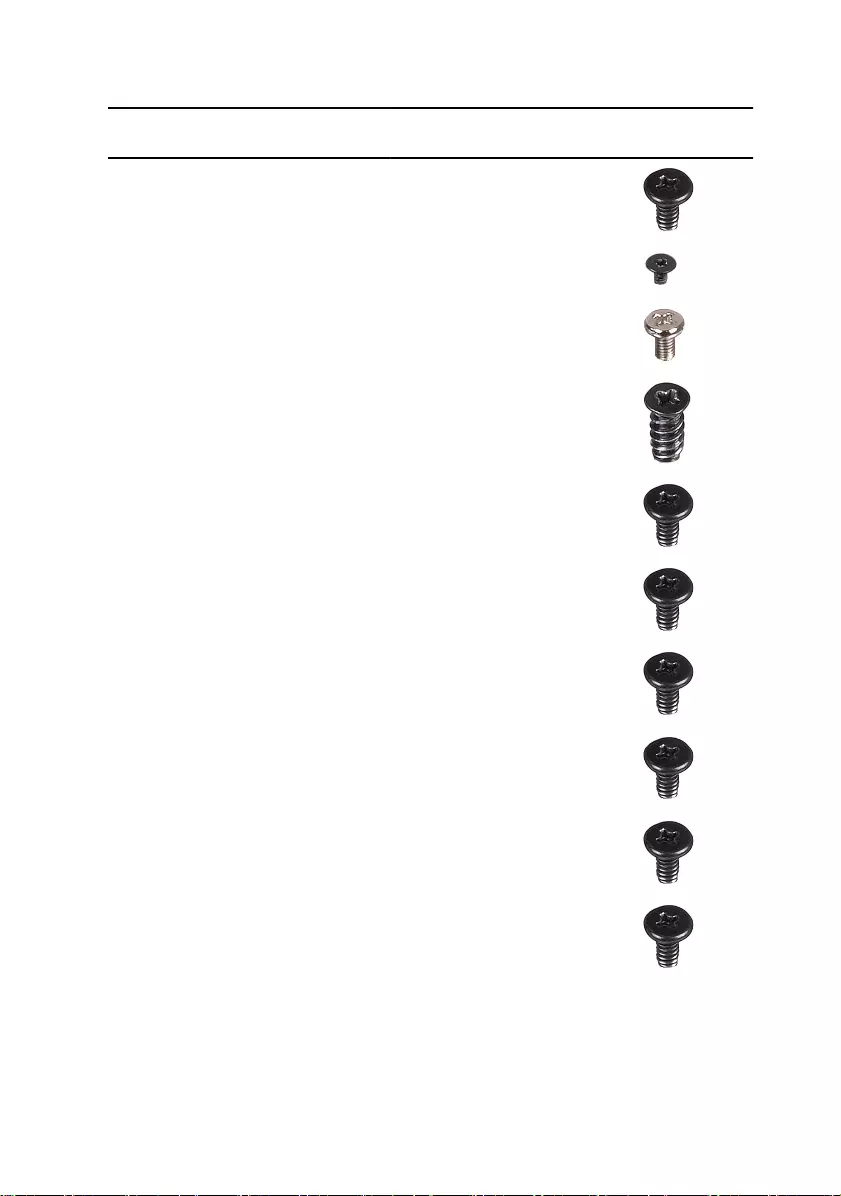
Component Secured to Screw type Quantity Screw
image
Logo board Bracket #6-32x6 6
Solid-state
drive
System board M2x2.5 1
PCI fan Chassis M3x5.25 2
Fan shroud PCI fan M5x10 4
Processor
liquid-cooling
assembly
Chassis #6-32x6 4
Power-supply
unit
Chassis #6-32x6 4
System-board Chassis #6-32x6 9
Rear-handle
bar
Chassis #6-32x6.5 14
Front-handle
bar
Chassis #6-32x6.5 14
Bottom-handle
bar
Chassis #6-32x6.5 14
18

Component Secured to Screw type Quantity Screw
image
Front bezel Chassis #6-32x6 4
Front bezel Chassis 6-32x5.2 3
Optical-drive
eject-button
board
Chassis #6-32x6 2
Rear bezel Chassis #6-32x6 4
Rear bezel Chassis M3x5 2
Base panel Chassis #6-32x6 4
Base panel Chassis #6-32x6 5
Antennas Chassis #6-32x6 6
19

After working inside your
computer
CAUTION: Leaving stray or loose screws inside your computer may
severely damage your computer.
1 Replace all screws and ensure that no stray screws remain inside your
computer.
2 Connect any external devices, peripherals, or cables you removed before
working on your computer.
3 Replace any media cards, discs, or any other parts that you removed before
working on your computer.
4 Connect your computer and all attached devices to their electrical outlets.
5 Turn on your computer.
20

Technical overview
WARNING: Before working inside your computer, read the safety
information that shipped with your computer and follow the steps in
Before working inside your computer. After working inside your
computer, follow the instructions in After working inside your
computer. For more safety best practices, see the Regulatory
Compliance home page at www.dell.com/regulatory_compliance.
Inside view of your computer
To view the different components installed in your computer. See “Left view” and
“Right view”.
21

Left view
Figure 1. Left view
1 processor liquid-cooling assembly
fan
2 graphics card
3 system board 4 power-supply unit
5 AlienFX side-panel connector 6 PCI fan
7 processor liquid-cooling assembly
pump
8 memory modules
9 top fan
22

Right view
Figure 2. Right view
1 optical drive (ODD) 2 I/O board (IO BRD)
3 drive-bay heat-sensor 4 2.5-inch drive bracket (HDD4/
HDD5)
5 AlienFX side-panel connector 6 rear I/O accessibility lighting
batteries
7 3.5-inch drive bracket (HDD1) 8 3.5-inch drive bracket (HDD2)
9 3.5-inch drive bracket (HDD3)
23

System-board components
1 processor liquid cooling-assembly
fan (LCM_FAN1)
2 audio connector
3 PCI-Express slot (SLOT1) 4 PCI-Express slot (SLOT3)
5 PCI-Express slot (SLOT4) 6 wireless card slot (M2_WLAN1)
24

7 PCI-Express slot (SLOT5) 8 PCI-Express slot (SLOT6)
9 solid-state drive slot (M2_SSD1) 10 PCI-Express slot (SLOT7)
11 low pin count debug header
(LPC1)
12 USB connector (USB2)
13 LED Power Switch (PANEL1) 14 USB connector (USB1)
15 drive-bay heat-sensor connector
(SENSOR1)
16 chassis heat-sensor connector
(SENSOR2)
17 PCI-Express power connector
(PCIE_PWR1)
18 PCI-Express fan 1 connector
(PCI_FAN1)
19 password reset jumper
(PASSWORD_CLR1)
20 SATA drive connector
(HDD_SATA3_4)
21 SATA drive connector
(HDD_SATA1_2)
22 USB connector (FUSB3_MB2)
23 USB connector (FUSB3_MB1) 24 U.2 SSD connector (not
supported)
25 coin-cell battery socket (BAT1) 26 CMOS reset jumper
(RTC_CLR1)
27 Advanced Technology xTended
(ATX) power connector (ATX
PWR1)
28 processor socket (CPU1)
29 memory-module slot (DIMM3) 30 memory-module slot (DIMM4)
31 processor liquid-cooling assembly
fan connector (MID_FAN1)
32 top fan connector (TOP_FAN1)
33 processor-power connector (CPU
PWR1)
34 processor liquid-cooling
assembly pump-fan connector
(PUMP_FAN1)
35 memory-module slot (DIMM2) 36 memory-module slot (DIMM1)
I/O-board components
NOTE: The location of the connectors may vary based on the
selections you made at the time of purchase.
25

Figure 3. I/O-board components
1 rear I/O accessibility lighting
battery connector (VBAT1)
2 rear I/O accessibility lighting
connector (PORCH_LIGHT1)
3 left theater-lighting connector
(POGO_IN_L1)
4 right theater-lighting connector
(POGO_IN_R1)
5 USB connector (USB1) 6 debug connector (DEBUG1)
7 front I/O control connector
(FIO_PWR1)
8 front I/O connector (USB3_FIO1)
9 main-power connector (PWR1) 10 optical drive power connector
(ODD1)
11 logo board connector (LOGO1) 12 audio connector (AUDIOIO1)
26

Lifting the computer
Procedure
1 With both hands, hold the handle located on top of the computer.
27

2 Lift the computer.
Figure 4. Lifting the computer
1 handle 2 computer
28

Removing the stability foot
WARNING: Before working inside your computer, read the safety
information that shipped with your computer and follow the steps in
Before working inside your computer. After working inside your
computer, follow the instructions in After working inside your
computer. For more safety best practices, see the Regulatory
Compliance home page at www.dell.com/regulatory_compliance.
Procedure
1 Tilt the computer towards the front until the base is facing up.
Figure 5. Tilt the computer
2 Remove the two screws (#6-32x6) that secure the stability foot to the
computer.
29

3 Lift the stability foot off the computer.
Figure 6. Removing the stability foot
1 stability foot 2 screws (2)
3 computer
30

4 Tilt the computer back to the upright position.
Figure 7. Tilt the computer to upright position
31

Replacing the stability foot
WARNING: Before working inside your computer, read the safety
information that shipped with your computer and follow the steps in
Before working inside your computer. After working inside your
computer, follow the instructions in After working inside your
computer. For more safety best practices, see the Regulatory
Compliance home page at www.dell.com/regulatory_compliance.
Procedure
1 Tilt the computer towards the front until the base is facing up.
2 Align the screw holes on the stability foot with the screw holes on the base
of the computer and replace the two screws (#6-32x6).
3 Tilt the computer back to the upright position.
32

Removing the side panels
WARNING: Before working inside your computer, read the safety
information that shipped with your computer and follow the steps in
Before working inside your computer. After working inside your
computer, follow the instructions in After working inside your
computer. For more safety best practices, see the Regulatory
Compliance home page at www.dell.com/regulatory_compliance.
Procedure
NOTE: Make sure that you remove the security cable from the
security-cable slot (if applicable).
1 Remove the screw (M2x3) that secures the security-cable slot latch.
The security-cable slot latch slides to the unlocked position.
2 Lift the release panel to open the right side-panel.
33

3 Pull and lift the right side-panel away from the chassis.
Figure 8. Removing the side panel
1 screw 2 security-cable slot latch
3 release panel 4 right side-panel
4 Repeat the procedure from step 2 to step 3 on the left side-panel.
34

Replacing the side panels
WARNING: Before working inside your computer, read the safety
information that shipped with your computer and follow the steps in
Before working inside your computer. After working inside your
computer, follow the instructions in After working inside your
computer. For more safety best practices, see the Regulatory
Compliance home page at www.dell.com/regulatory_compliance.
Procedure
1 Align the tabs on the right side-panel with the slots on the right side of the
computer and snap the panel to lock it in place.
2 Repeat step 1 to replace the left side-panel.
3 Slide and hold the security-cable slot latch in the locked position.
4 Replace the screw (M2x3) that secures the security-cable slot latch.
35

Removing the battery
WARNING: Before working inside your computer, read the safety
information that shipped with your computer and follow the steps in
Before working inside your computer. After working inside your
computer, follow the instructions in After working inside your
computer. For more safety best practices, see the Regulatory
Compliance home page at www.dell.com/regulatory_compliance.
Prerequisites
Remove the right side-panel. See “Removing the side panels”.
Procedure
1 Remove the screw (M2x5.7) that secures the battery-case door to the
battery case.
36

2 Slide and open the battery-case door and remove the batteries from the
battery case.
Figure 9. Removing the batteries
1 screw 2 battery-case door
3 AA batteries (2)
37

Replacing the battery
WARNING: Before working inside your computer, read the safety
information that shipped with your computer and follow the steps in
Before working inside your computer. After working inside your
computer, follow the instructions in After working inside your
computer. For more safety best practices, see the Regulatory
Compliance home page at www.dell.com/regulatory_compliance.
Procedure
1 Insert the batteries into the battery-case.
2 Slide and close the battery-case door.
3 Replace the screw (M2x5.7) that secures the battery-case door to the
battery case.
Post-requisites
Replace the right side-panel. See “Replacing the side panels”.
38

Removing the battery case
WARNING: Before working inside your computer, read the safety
information that shipped with your computer and follow the steps in
Before working inside your computer. After working inside your
computer, follow the instructions in After working inside your
computer. For more safety best practices, see the Regulatory
Compliance home page at www.dell.com/regulatory_compliance.
Prerequisites
1 Remove the stability foot.
2 Remove the right side-panel. See “Removing the side panels”.
3 Remove the battery.
Procedure
1 Lay the chassis on the left side.
2 Press the release tabs on the cable connector to disconnect the battery-
case cable from the I/O board.
3 Remove the two screws (#6-32x5.2) that secure the battery case to the
chassis.
39

4 Lift the battery case off the chassis.
Figure 10. Remove the battery-case
1 battery-case cable 2 battery-case connector
3 battery case 4 screws (2)
40

Replacing the battery case
WARNING: Before working inside your computer, read the safety
information that shipped with your computer and follow the steps in
Before working inside your computer. After working inside your
computer, follow the instructions in After working inside your
computer. For more safety best practices, see the Regulatory
Compliance home page at www.dell.com/regulatory_compliance.
Procedure
1 Align the screw holes on the battery case with the screw holes on the
chassis.
2 Replace the two screws (#6-32x5.2) that secure the battery case to the
chassis.
3 Connect the battery-case cable to the I/O board.
Post-requisites
1 Replace the battery.
2 Replace the right side-panel. See “Replacing the side panels”.
3 Replace the stability foot.
41

Removing the hard drive
WARNING: Before working inside your computer, read the safety
information that shipped with your computer and follow the steps in
Before working inside your computer. After working inside your
computer, follow the instructions in After working inside your
computer. For more safety best practices, see the Regulatory
Compliance home page at www.dell.com/regulatory_compliance.
CAUTION: Hard drives are fragile. Exercise care when handling the
hard drive.
CAUTION: To avoid data loss, do not remove the hard drive while the
computer is in sleep or on state.
Prerequisites
1 Remove the stability foot.
2 Remove the left and right side-panels. See “Removing the side panels”.
Procedure
1 Lay the chassis on the left side.
2 Disconnect the power cable and data cable from the hard-drive assembly
(HDD1).
3 Remove the screw (#6-32x6) that secures the hard-drive assembly (HDD1)
to the chassis.
42

4 Using the tab, slide and remove the hard-drive assembly (HDD1) from the
chassis.
Figure 11. Removing the hard drive
1 power cable 2 data cable
3 chassis 4 screw
5 tab 6 hard-drive assembly
(HDD1)
5 Remove the four screws (#6-32x3.6) that secure the hard-drive bracket to
the hard drive.
43

6 Slide and remove the hard drive from the hard-drive bracket.
NOTE: Repeat step 2 to step 6 to remove any other hard drives
(HDD2 and HDD3) installed in your computer.
Figure 12. Removing the hard-drive bracket
1 screws (4) 2 hard drive
3 hard-drive bracket
44

Replacing the hard drive
WARNING: Before working inside your computer, read the safety
information that shipped with your computer and follow the steps in
Before working inside your computer. After working inside your
computer, follow the instructions in After working inside your
computer. For more safety best practices, see the Regulatory
Compliance home page at www.dell.com/regulatory_compliance.
CAUTION: Hard drives are fragile. Exercise care when handling the
hard drive.
Procedure
1 Align the screw holes on the hard-drive bracket with the screw holes on the
hard drive (HDD1).
2 Replace the four screws (#6-32x3.6) that secure the hard drive to the hard-
drive bracket.
3 Place the hard-drive assembly (HDD1) in the chassis.
4 Replace the screw (#6-32x6) that secures the hard-drive assembly (HDD1)
to the chassis.
5 Connect the power cable and data cable to the hard drive (HDD1).
NOTE: Repeat step 2 to step 5 to replace any other hard drives
(HDD2 and HDD3) installed in your computer.
Post-requisites
1 Replace the left and right side-panels. See “Replacing the side panels”.
2 Replace the stability foot.
45

Removing the optical drive
WARNING: Before working inside your computer, read the safety
information that shipped with your computer and follow the steps in
Before working inside your computer. After working inside your
computer, follow the instructions in After working inside your
computer. For more safety best practices, see the Regulatory
Compliance home page at www.dell.com/regulatory_compliance.
Prerequisites
1 Remove the stability foot.
2 Remove the left and right side-panels. See “Removing the side panels”.
Procedure
1 Lay the chassis on the left side.
2 Disconnect the power and data cable from the optical drive.
3 Remove the screw (#6-32x6) that secures the optical-drive assembly to the
chassis.
46

4 Slide and lift the optical-drive assembly off the chassis.
Figure 13. Removing the optical-drive assembly
1 screw 2 optical-drive assembly
3 data cable and power cable
5 Remove the two screws (M2x3) that secure the optical-drive bracket to the
optical drive.
47

6 Slide and remove the optical drive from the optical-drive bracket.
Figure 14. Removing the optical drive
1 screws (2) 2 optical drive
3 optical-drive bracket
48

Replacing the optical drive
WARNING: Before working inside your computer, read the safety
information that shipped with your computer and follow the steps in
Before working inside your computer. After working inside your
computer, follow the instructions in After working inside your
computer. For more safety best practices, see the Regulatory
Compliance home page at www.dell.com/regulatory_compliance.
Procedure
1 Align the screw holes on the optical-drive bracket with the screw holes on
the optical drive.
2 Replace the two screws (M2x3) that secure the optical drive to the optical-
drive bracket.
3 Align the screw hole on the optical-drive assembly with the screw hole on
the chassis.
4 Replace the screw (#6-32x6) that secures the optical-drive bay assembly to
the chassis.
5 Plug the power cable and data cable to the optical drive.
Post-requisites
1 Replace the left and right side-panels. See “Replacing the side panels”.
2 Replace the stability foot.
49

Removing the right AlienFX side-
panel connector
WARNING: Before working inside your computer, read the safety
information that shipped with your computer and follow the steps in
Before working inside your computer. After working inside your
computer, follow the instructions in After working inside your
computer. For more safety best practices, see the Regulatory
Compliance home page at www.dell.com/regulatory_compliance.
Prerequisites
1 Remove the stability foot.
2 Remove the left and right side-panels. See “Removing the side panels”.
Procedure
1 Lay the chassis on the left side.
2 Disconnect the right AlienFX side-panel cable that connects the right
AlienFX side-panel connector to the I/O board. See “I/O-board components”.
3 Remove the screw (#6-32x6) that secures the right AlienFX side-panel
connector assembly to the chassis.
50

4 Remove the right AlienFX side-panel connector assembly from the chassis.
Figure 15. Image: Right AlienFX connector removal
1 screw 2 right AlienFX side-panel
connector assembly
3 right AlienFX side-panel
cable
4 right AlienFX side-panel
connector
5 Remove the two screws (#6-32x6) that secure the right AlienFX side-panel
connector to the bracket.
51

6 Remove the cable routing through the slot on the bracket and lift the right
AlienFX side-panel connector off the bracket.
Figure 16. Image: Right AlienFX connector removal
1 screws (2) 2 right AlienFX side-panel
connector
52

Replacing the right AlienFX side-
panel connector
WARNING: Before working inside your computer, read the safety
information that shipped with your computer and follow the steps in
Before working inside your computer. After working inside your
computer, follow the instructions in After working inside your
computer. For more safety best practices, see the Regulatory
Compliance home page at www.dell.com/regulatory_compliance.
Procedure
1 Route the cable through the slot on the bracket and align the screw holes on
the right AlienFX side-panel connector with the screw holes on the bracket.
2 Replace the two screws (#6-32x6) that secure the right AlienFX side-panel
connector to the bracket.
3 Align the screw hole on the right AlienFX side-panel connector assembly
with the screw hole on the chassis.
4 Replace the screw (#6-32x6) that secures the right AlienFX side-panel
connector assembly to the chassis.
5 Connect the cable that connects the right AlienFX side-panel connector to
the I/O board. See “I/O-board components”.
Post-requisites
1 Replace the left and right side-panels. See “Replacing the side panels”.
2 Replace the stability foot.
53

Removing the left AlienFX side-
panel connector
WARNING: Before working inside your computer, read the safety
information that shipped with your computer and follow the steps in
Before working inside your computer. After working inside your
computer, follow the instructions in After working inside your
computer. For more safety best practices, see the Regulatory
Compliance home page at www.dell.com/regulatory_compliance.
Prerequisites
1 Remove the stability foot.
2 Remove the left and right side-panels. See “Removing the side panels”.
Procedure
1 Lay the chassis on the left side.
54

2 Disconnect the cable that connects the left AlienFX side-panel connector to
the I/O board. See “I/O-board components”.
Figure 17. Image: Left AlienFX connector removal
1 left AlienFX side-panel
connector
2 left AlienFX side-panel
cable
3 I/O board
3 Turn the chassis over.
4 Remove the AlienFX side-panel cable through the routing guides on the
chassis.
5 Remove the screw (#6-32x6) that secures the left AlienFX side-panel
connector assembly to the chassis.
55

6 Remove the left AlienFX side-panel connector assembly from the chassis.
Figure 18. Image: Left AlienFX connector removal
1 screw 2 left AlienFX side-panel
connector assembly
7 Remove the two screws (#6-32x6) that secure the AlienFX side-panel
connector to the bracket.
56
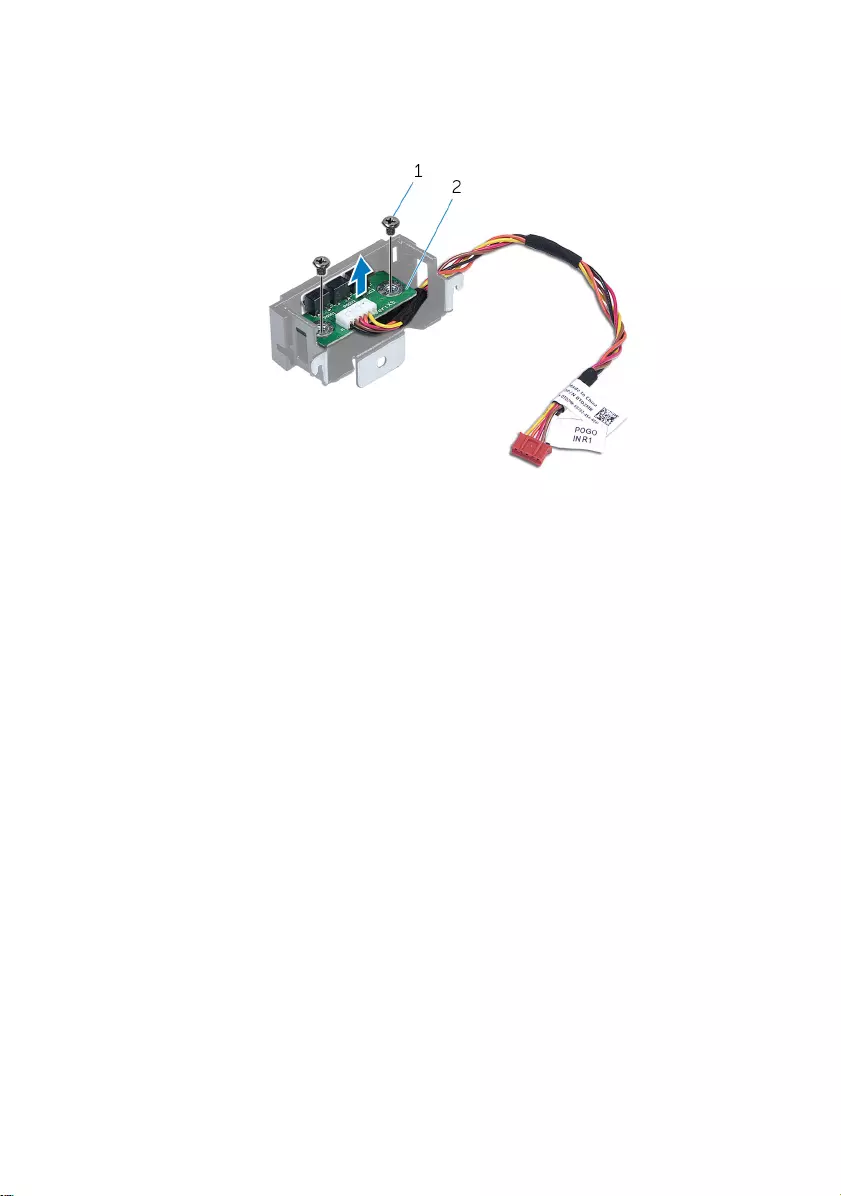
8 Remove the cable routing through the slot on the bracket and lift the left
AlienFX side-panel connector off the bracket.
Figure 19. Image: Left AlienFX connector removal
1 screw 2 left AlienFX side-panel
connector
57

Replacing the left AlienFX side-
panel connector
WARNING: Before working inside your computer, read the safety
information that shipped with your computer and follow the steps in
Before working inside your computer. After working inside your
computer, follow the instructions in After working inside your
computer. For more safety best practices, see the Regulatory
Compliance home page at www.dell.com/regulatory_compliance.
Procedure
1 Route the cable through the slot on the bracket and align the screw holes on
the left AlienFX side-panel connector with the screw holes on the bracket.
2 Replace the two screws (#6-32x6) that secure the AlienFX side-panel
connector to the bracket.
3 Align the screw hole on the left AlienFX side-panel connector with the screw
hole on the chassis.
4 Replace the screw (#6-32x6) that secures the left AlienFX side-panel
connector to the chassis.
5 Connect the cable that connects the left AlienFX side-panel connector to the
system board. See “I/O-board components”.
Post-requisites
1 Replace the left and right side-panels. See “Replacing the side panels”.
2 Replace the stability foot.
58

Removing the I/O board
WARNING: Before working inside your computer, read the safety
information that shipped with your computer and follow the steps in
Before working inside your computer. After working inside your
computer, follow the instructions in After working inside your
computer. For more safety best practices, see the Regulatory
Compliance home page at www.dell.com/regulatory_compliance.
Prerequisites
1 Remove the stability foot.
2 Remove left and right side-panels. See “Removing the side panels”.
Procedure
1 Lay the chassis on the left side.
59

2 Disconnect all cables from the I/O board.
NOTE: Note the routing of all cables as you remove them so that
you can route them correctly after you replace the I/O board.
Figure 20. Removing the I/O board
1 cables 2 I/O board
3 Remove the five screws (#6-32x6) that secure the I/O board to the chassis.
60

4 Slide and lift the I/O board out of the chassis.
Figure 21. Removing the I/O board
1 I/O board 2 screws (5)
61

Replacing the I/O board
WARNING: Before working inside your computer, read the safety
information that shipped with your computer and follow the steps in
Before working inside your computer. After working inside your
computer, follow the instructions in After working inside your
computer. For more safety best practices, see the Regulatory
Compliance home page at www.dell.com/regulatory_compliance.
Procedure
1 Align the ports on the I/O board with their respective slots on the chassis
and slide it into place.
2 Align the screw holes on the I/O board to the screw holes on the chassis.
3 Replace the five screws (#6-32x6) that secure the I/O board to the chassis.
4 Connect the cables to the I/O board.
NOTE: The connectors on the I/O board are color coded. Make
sure that you match the color of the I/O board connector with the
cable connector. For more information on I/O connectors, see I/O-
board components”.
Post-requisites
1 Replace left and right side-panels. See “Replacing the side panels”.
2 Replace the stability foot.
62

Removing the drive-bay heat
sensor cable
WARNING: Before working inside your computer, read the safety
information that shipped with your computer and follow the steps in
Before working inside your computer. After working inside your
computer, follow the instructions in After working inside your
computer. For more safety best practices, see the Regulatory
Compliance home page at www.dell.com/regulatory_compliance.
Prerequisites
1 Remove the stability foot.
2 Remove the left and right side-panels. See “Removing the side panels”.
Procedure
1 Lay the chassis on the right side.
63

2 Disconnect the drive-bay heat-sensor cable from the system board.
Figure 22. Removing the drive-bay heat-sensor cable
1 drive-bay heat-sensor
connector
2 drive-bay heat-sensor cable
3 Turn the chassis over.
4 Remove the cable through the slot on the chassis.
5 Locate the drive-bay heat-sensor. See “right view”.
64

6 Push the release tab and pry the drive-bay heat-sensor cable off the
chassis.
Figure 23. Removing the drive-bay heat-sensor cable
1 release tab 2 drive-bay heat-sensor cable
65

Replacing the drive-bay heat
sensor cable
WARNING: Before working inside your computer, read the safety
information that shipped with your computer and follow the steps in
Before working inside your computer. After working inside your
computer, follow the instructions in After working inside your
computer. For more safety best practices, see the Regulatory
Compliance home page at www.dell.com/regulatory_compliance.
Procedure
1 Route the drive-bay heat-sensor cable through the slot on the chassis.
2 Align the tab on the drive-bay heat-sensor cable on the chassis.
3 Push the release tab on the drive-bay heat-sensor cable and press it into
place.
4 Lay the chassis on the left side.
5 Connect the drive-bay heat-sensor cable to the system board. See “system-
board components.
Post-requisites
1 Replace the left and right side-panels. See “Replacing the side panels”.
2 Replace the stability foot.
66

Removing the memory modules
WARNING: Before working inside your computer, read the safety
information that shipped with your computer and follow the steps in
Before working inside your computer. After working inside your
computer, follow the instructions in After working inside your
computer. For more safety best practices, see the Regulatory
Compliance home page at www.dell.com/regulatory_compliance.
Prerequisites
1 Remove the stability foot.
2 Remove the left and right side-panels. See “Removing the side panels”.
Procedure
1 Lay the chassis on the left side.
2 Locate the memory modules on the system board. For more information on
the memory modules see “system-board components”.
3 Use your fingertips to carefully spread apart the securing-clips on each end
of the memory-module slot.
67
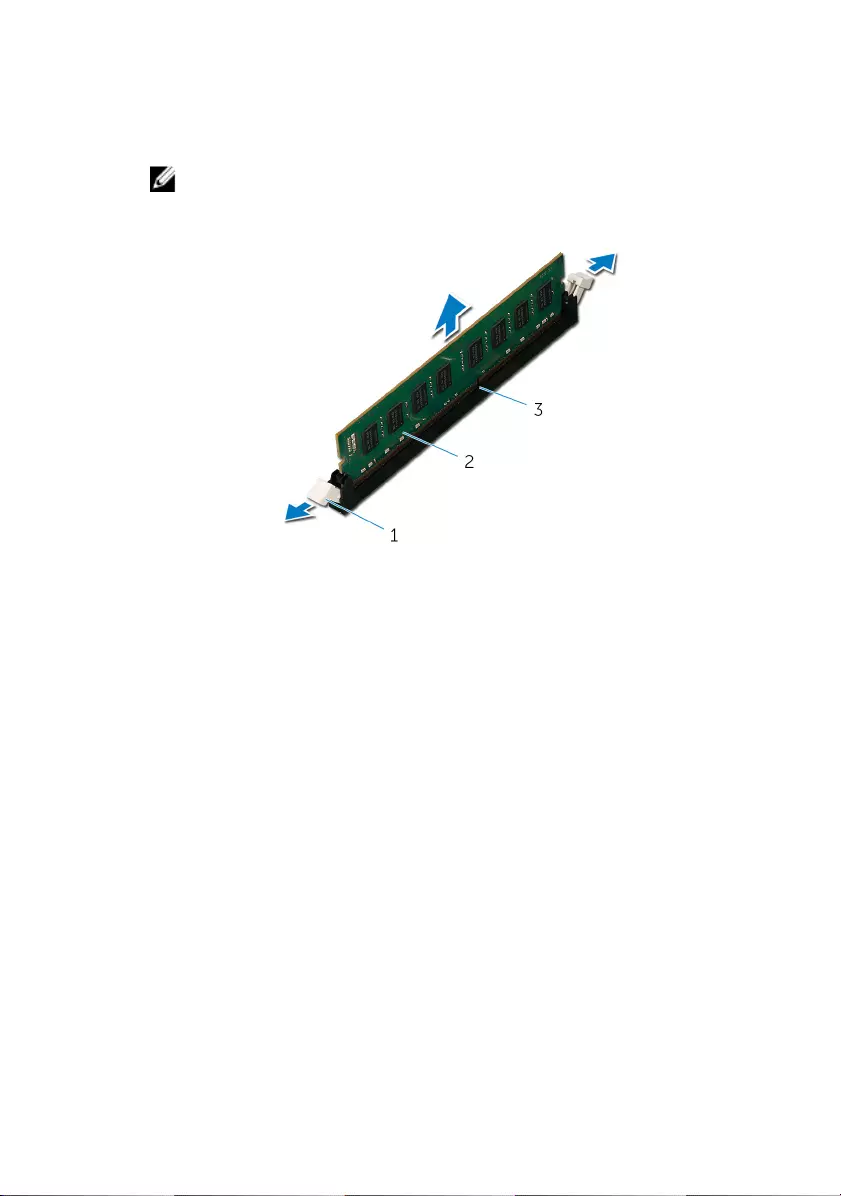
4 Grasp the memory module near the securing clip, and then gently ease the
memory module out of the memory-module slot.
NOTE: Repeat step 2 to step 3 to remove any other memory
modules installed in your computer.
Figure 24. Removing the memory module
1 securing clips (2) 2 memory module
3 memory-module slot
68

Replacing the memory modules
WARNING: Before working inside your computer, read the safety
information that shipped with your computer and follow the steps in
Before working inside your computer. After working inside your
computer, follow the instructions in After working inside your
computer. For more safety best practices, see the Regulatory
Compliance home page at www.dell.com/regulatory_compliance.
Procedure
1 Align the notch on the memory module with the tab on the memory-module
slot.
69

2 Insert the memory module into the memory-module connector until the
memory module snaps into position and the securing clip locks in place.
NOTE: The securing clips return to the locked position. If you do
not hear the click, remove the memory module and reinstall it.
1 memory module 2 memory-module slot
3 notch 4 tab
5 securing clip
Post-requisites
1 Replace the left and right side-panels. See “Replacing the side panels”.
2 Replace the stability foot.
70

Removing the graphics card
WARNING: Before working inside your computer, read the safety
information that shipped with your computer and follow the steps in
Before working inside your computer. After working inside your
computer, follow the instructions in After working inside your
computer. For more safety best practices, see the Regulatory
Compliance home page at www.dell.com/regulatory_compliance.
Prerequisites
1 Remove the stability foot.
2 Remove the left and right side-panels. See “Removing the side panels”.
Procedure
1 Lay the chassis on the right side.
2 Press the releasing clip on the power-cable connectors and disconnect the
power cables from the graphics card.
3 Press and push the screw covers covering the screws that secure the
graphics card to the chassis.
4 Remove the two screws (#6-32x6) that secure the graphics card to the
chassis.
71

5 Press the release tabs on the power-cable connectors to disconnect the
power cables from the graphics card.
NOTE: The location of the power supply connector (PCIE1, PCIE2
and PCIE3) varies depending on the video card installed.
Figure 25. Removing the graphics card
1 screw cover 2 screws (2)
3 graphics card 4 power cables (2)
72

6 Press and hold the securing tab on the graphics-card connector, grasp the
card by its top corners, and then ease the card out of the slot.
Figure 26. Removing the graphics card
1 graphics card 2 securing tab
73

Replacing the graphics card
WARNING: Before working inside your computer, read the safety
information that shipped with your computer and follow the steps in
Before working inside your computer. After working inside your
computer, follow the instructions in After working inside your
computer. For more safety best practices, see the Regulatory
Compliance home page at www.dell.com/regulatory_compliance.
Procedure
1 Align the graphics card with the PCI-Express card connector on the system
board.
2 Place the card in the connector and press down firmly. Ensure that the card
is firmly seated.
3 Replace the two screws (#6-32x6) that secure the graphics card to the
chassis.
4 Connect the power cables to the graphics card.
NOTE: The location of the power supply connector (PCIE1, PCIE2
and PCIE3) varies depending on the video card installed.
5 From outside the chassis, push the screw covers inside to cover the screws
that secure the graphics card to the chassis.
6 Connect the power cables to the graphics card.
Post-requisites
1 Replace the left and right side-panels. See “Replacing the side panels”.
2 Replace the stability foot.
74

Removing multiple graphics
cards
WARNING: Before working inside your computer, read the safety
information that shipped with your computer and follow the steps in
Before working inside your computer. After working inside your
computer, follow the instructions in After working inside your
computer. For more safety best practices, see the Regulatory
Compliance home page at www.dell.com/regulatory_compliance.
Prerequisites
1 Remove the stability foot.
2 Remove the left and right side-panels. See “Removing the side panels”.
Procedure
1 Lay the chassis on the right side.
75

2 Lift the graphics bridge that connects the graphics cards.
Figure 27. Removing the graphics bridge
1 graphics bridge
3 Starting with the graphics card on the PCI-Express card connector (SLOT1),
press and push the screw covers covering the screws that secure the
graphics card.
4 Remove the two screws (#6-32x6) that secure the graphics card to the
chassis.
76

5 Press the release tabs on the power-cable connectors to disconnect the
power cables from the graphics card.
NOTE: The location of the power supply connector (PCIE1, PCIE2
and PCIE3) varies depending on the video card installed.
Figure 28. Removing multiple graphics cards
1 screw cover 2 screws (2)
3 power cables (2)
77
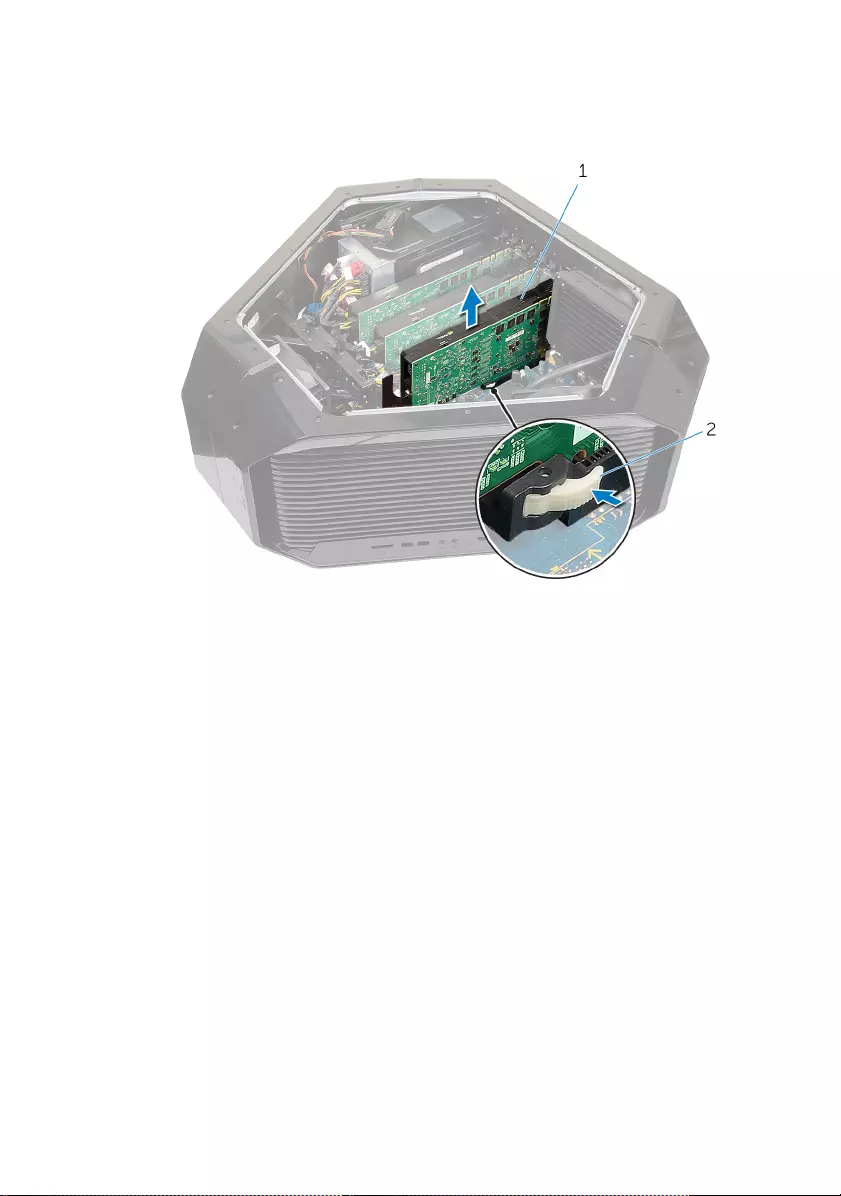
6 Press and hold the securing tab on the card connector, grasp the card by its
top corners, and then ease the card out of the card connector.
Figure 29. Removing multiple graphics cards
1 graphics card 2 securing tab
7 Repeat steps 2 to 7 to remove graphics card on the PCI-Express card
connector (SLOT4) and PCI-Express x16 card connector (SLOT7).
78

Replacing multiple graphics
cards
WARNING: Before working inside your computer, read the safety
information that shipped with your computer and follow the steps in
Before working inside your computer. After working inside your
computer, follow the instructions in After working inside your
computer. For more safety best practices, see the Regulatory
Compliance home page at www.dell.com/regulatory_compliance.
Procedure
1 Place the card in the connector and press the card down firmly. Ensure that
the card is firmly seated in the slot.
2 Replace the two screws (#6-32x6) that secure the graphics card to the
chassis.
3 Place the graphics bridge that connects the graphics cards.
4 Connect the power cables to the graphics card.
NOTE: The location of the power supply connector (PCIE1, PCIE2
and PCIE3) varies depending on the video card installed.
5 From outside the chassis, push the screw covers inside to cover the screws
that secure the graphics card.
Post-requisites
1 Replace the left and right side-panels. See “Replacing the side panels”.
2 Replace the stability foot.
79

Removing the full-length
graphics cards
WARNING: Before working inside your computer, read the safety
information that shipped with your computer and follow the steps in
Before working inside your computer. After working inside your
computer, follow the instructions in After working inside your
computer. For more safety best practices, see the Regulatory
Compliance home page at www.dell.com/regulatory_compliance.
Prerequisites
1 Remove the stability foot.
2 Remove the left and right side-panels. See “Removing the side panels”.
Procedure
1 Lay the chassis on the right side.
2 Locate the graphics card (PCI-Express card connector) on the system
board. For more information on the graphics connector, see “system-board
components”.
3 Press and hold the securing tab on the clamp.
80
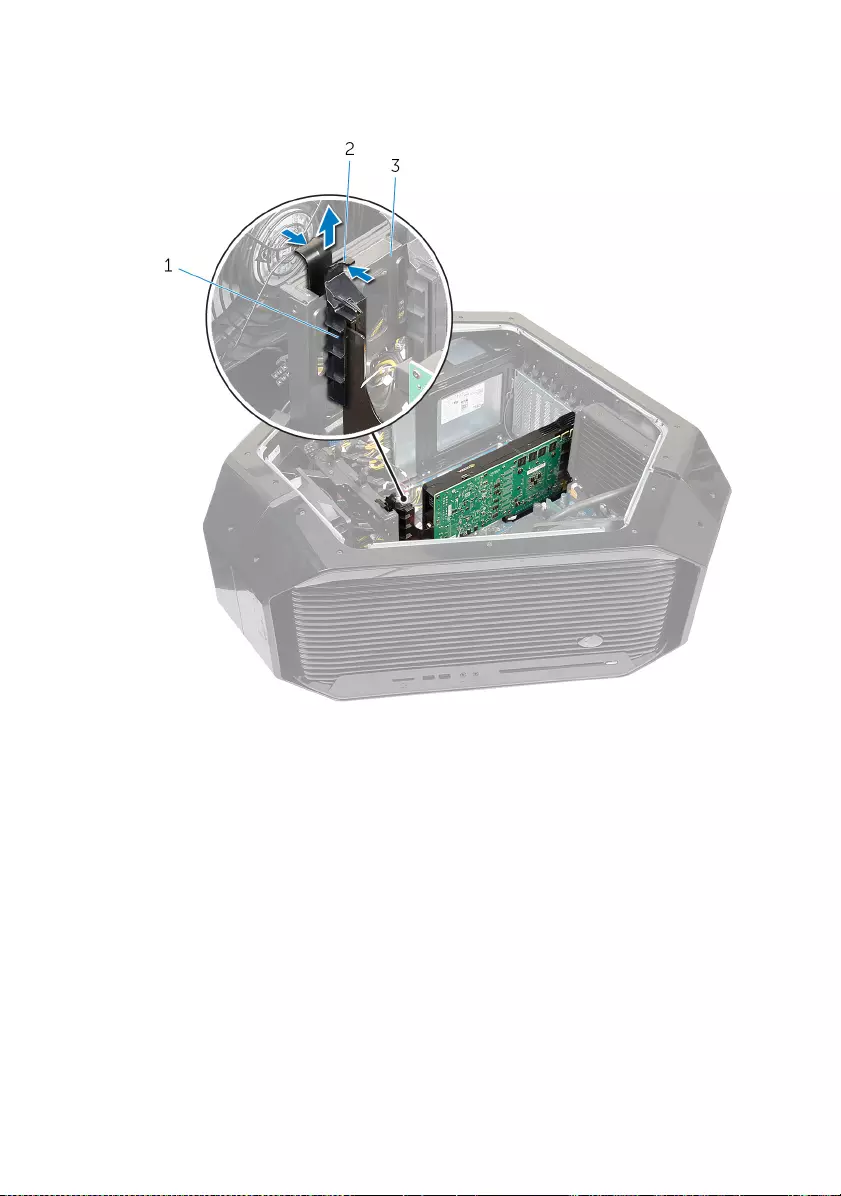
4 Pull the clamp away from the bracket.
Figure 30. Removing the Full length graphics card
1 clamp 2 securing tab
3 bracket
5 Press and push the screw covers covering the screws that secure the
graphics card to the chassis.
6 Remove the two screws (#6-32x6) that secure the graphics card to the
chassis.
81

7 Press the release tabs on the power-cable connectors to disconnect the
power cables from the graphics card.
NOTE: The location of the power supply connector (PCIE1, PCIE2
and PCIE3) varies depending on the video card installed.
Figure 31. Removing the Full length graphics card
1 screw cover 2 screws (2)
3 power cables (2)
82

8 Press and hold the securing tab on the card connector, grasp the card by its
top corners, and then ease the card out of the card connector.
Figure 32. Removing the Full length graphics card
1 graphics card 2 securing tab
83

Replacing the full-length graphics
cards
WARNING: Before working inside your computer, read the safety
information that shipped with your computer and follow the steps in
Before working inside your computer. After working inside your
computer, follow the instructions in After working inside your
computer. For more safety best practices, see the Regulatory
Compliance home page at www.dell.com/regulatory_compliance.
Procedure
1 Align the graphics card with the PCI-Express card connector on the system
board.
2 Place the card in the connector and press the card down firmly. Ensure that
the card is firmly seated.
3 Press and hold the securing tab on the clamp.
4 Push the clamp back towards the bracket.
5 Replace the two screws (#6-32x6) that secure the graphics card to the
chassis.
6 Connect the power cables to the graphics card.
NOTE: The location of the power supply connector (PCIE1, PCIE2
and PCIE3) varies depending on the video card installed.
7 From outside the chassis, push the screw covers inside to cover the screws
that secure the graphics card.
Post-requisites
1 Replace the left and right side-panels. See “Replacing the side panels”.
2 Replace the stability foot.
84

Removing the wireless card
WARNING: Before working inside your computer, read the safety
information that shipped with your computer and follow the steps in
Before working inside your computer. After working inside your
computer, follow the instructions in After working inside your
computer. For more safety best practices, see the Regulatory
Compliance home page at www.dell.com/regulatory_compliance.
Prerequisites
1 Remove the stability foot. See “Removing the stability foot”.
2 Remove the left and right side-panels. See “Removing the side panels”.
3 If you have multiple graphics cards installed, remove the graphics card. See
“Removing multiple graphics cards”.
Procedure
1 Lay the chassis on the right side.
2 Disconnect the antenna cables from the wireless card.
3 Remove the screw (M2x3) that secures the wireless card to the chassis.
85

4 Slide and remove the wireless card from the wireless-card slot.
Figure 33. Removing the wireless card
1 antenna cables 2 screw
3 wireless card 4 wireless-card slot
86

Replacing the wireless card
WARNING: Before working inside your computer, read the safety
information that shipped with your computer and follow the steps in
Before working inside your computer. After working inside your
computer, follow the instructions in After working inside your
computer. For more safety best practices, see the Regulatory
Compliance home page at www.dell.com/regulatory_compliance.
Procedure
1 Align the notch on the wireless card with the tab on the wireless-card slot.
2 Insert the wireless card at an angle into the connector.
3 Replace the screw (M2x3) that secures the wireless card to the chassis.
4 Connect the antenna cables to the wireless card.
A label at the tip of the antenna cables indicates the color scheme for the
wireless card supported by your computer.
Table 2. Antenna-cable color scheme
Connectors on the wireless card Antenna-cable sticker color
Auxiliary (1) Black
Main (2) White
Post-requisites
1 If you have multiple graphics cards, replace the graphics card. See
“Replacing multiple graphics cards”.
2 Replace the left and right side-panels. See “Replacing the side panels”.
3 Replace the stability foot.
87

Removing the coin-cell battery
WARNING: Before working inside your computer, read the safety
information that shipped with your computer and follow the steps in
Before working inside your computer. After working inside your
computer, follow the instructions in After working inside your
computer. For more safety best practices, see the Regulatory
Compliance home page at www.dell.com/regulatory_compliance.
CAUTION: Removing the coin-cell battery resets the BIOS setup
program’s settings to default. It is recommended that you note the
BIOS setup program’s settings before removing the coin-cell battery.
Prerequisites
1 Remove the stability foot.
2 Remove the left and right side-panels. See “Removing the side panels”.
3 If you have multiple graphics cards installed, remove the graphics card. See
“Removing multiple graphics cards”.
Procedure
1 Lay the chassis on the right side.
88

2 Push the coin-cell battery-release lever to remove the coin-cell battery.
Figure 34. Removing the coin-cell battery
1 coin-cell battery-release
lever
2 coin-cell battery
89

Replacing the coin-cell battery
WARNING: Before working inside your computer, read the safety
information that shipped with your computer and follow the steps in
Before working inside your computer. After working inside your
computer, follow the instructions in After working inside your
computer. For more safety best practices, see the Regulatory
Compliance home page at www.dell.com/regulatory_compliance.
Procedure
Insert the coin-cell battery into the socket with the side labeled + facing up and
press down the battery in the socket.
Post-requisites
1 If you have multiple graphics cards installed, replace the graphics cards.
See “Replacing multiple graphics cards”.
2 Replace the left and right side-panels. See “Replacing the side panels”.
3 Remove the stability foot.
90

Removing the top fan
WARNING: Before working inside your computer, read the safety
information that shipped with your computer and follow the steps in
Before working inside your computer. After working inside your
computer, follow the instructions in After working inside your
computer. For more safety best practices, see the Regulatory
Compliance home page at www.dell.com/regulatory_compliance.
Prerequisites
1 Remove the stability foot.
2 Remove the left and right side-panels. See “Removing the side panels”.
Procedure
1 Lay the chassis on the right side.
2 Remove the screw (#6-32x6) that secures the top fan on the chassis.
3 Pull the release tab away from the chassis and move the top fan towards
the right side.
91

4 Lift the top fan out of the chassis.
Figure 35. Removing the top fan
1 top fan 2 release tab
3 screw 4 memory-fan cable
92

Replacing the top fan
WARNING: Before working inside your computer, read the safety
information that shipped with your computer and follow the steps in
Before working inside your computer. After working inside your
computer, follow the instructions in After working inside your
computer. For more safety best practices, see the Regulatory
Compliance home page at www.dell.com/regulatory_compliance.
Procedure
1 Align the tabs on the top fan with the slots on the chassis and slide the fan
until it snaps into position.
2 Replace the screw (#6-32x6) that secures the top fan on the chassis.
Post-requisites
1 Replace the left and right side-panels. See “Replacing the side panels”.
2 Replace the stability foot.
93

Removing the logo board
WARNING: Before working inside your computer, read the safety
information that shipped with your computer and follow the steps in
Before working inside your computer. After working inside your
computer, follow the instructions in After working inside your
computer. For more safety best practices, see the Regulatory
Compliance home page at www.dell.com/regulatory_compliance.
Prerequisites
1 Remove the stability foot.
2 Remove the left and right side-panels. See “Removing the side panels”.
3 Remove the top fan.
Procedure
NOTE: Note the routing of all cables as you remove them so that you
can route them correctly after you replace the logo board.
1 Lay the chassis on the right side.
2 Disconnect all the cables from the logo board.
3 Remove the screw (#6-32x6) that secures the logo board to the chassis.
94

4 Slide the logo board out of the chassis.
Figure 36. Removing the logo board
1 logo board 2 connector
3 screw
5 Remove the six screws (#6-32x6) that secure the logo board to the bracket.
95

6 Remove the logo board from the bracket.
Figure 37. Removing the logo board
1 screws (6) 2 logo-board bracket
3 logo board
96

Replacing the logo board
WARNING: Before working inside your computer, read the safety
information that shipped with your computer and follow the steps in
Before working inside your computer. After working inside your
computer, follow the instructions in After working inside your
computer. For more safety best practices, see the Regulatory
Compliance home page at www.dell.com/regulatory_compliance.
Procedure
1 Align the screw holes on the logo board to the screw holes on the bracket
and slide the logo board in place.
2 Replace the six screws (#6-32x6) that secure the logo board to the bracket.
3 Slide the logo board inside the chassis.
4 Replace the screw (#6-32x6) that secures the logo board to the bracket.
5 Route and connect the respective to the logo board.
Post-requisites
1 Replace the left and right side-panels. See “Replacing the side panels”.
2 Replace the stability foot.
97

Removing the solid-state drive
WARNING: Before working inside your computer, read the safety
information that shipped with your computer and follow the steps in
Before working inside your computer. After working inside your
computer, follow the instructions in After working inside your
computer. For more safety best practices, see the Regulatory
Compliance home page at www.dell.com/regulatory_compliance.
CAUTION: Solid-state drives are fragile. Exercise care when handling
the solid-state drive.
CAUTION: To avoid data loss, do not remove the solid-state drive
while the computer is in sleep or on state.
Prerequisites
1 Remove the stability foot.
2 Remove the left and right side-panels. See “Removing the side panels”.
Procedure
1 Lay the chassis on the right side.
2 Locate the solid-state drive on the system board. For more information on
the solid-state drive see “system-board components”.
3 Remove the screw (M2x2.5) that secures the solid-state drive to the system
board.
98

4 Slide and remove the solid-state drive from the solid-state drive slot on the
system board.
Figure 38. Removing the solid-state drive
1 screw 2 solid-state drive
3 solid-state drive slot
99

Replacing the solid-state drive
WARNING: Before working inside your computer, read the safety
information that shipped with your computer and follow the steps in
Before working inside your computer. After working inside your
computer, follow the instructions in After working inside your
computer. For more safety best practices, see the Regulatory
Compliance home page at www.dell.com/regulatory_compliance.
CAUTION: Solid-state drives are fragile. Exercise care when handling
the solid-state drive.
Procedure
1 Align the notch on the solid-state drive with the tab on the solid-state drive
slot and slide the solid-state drive into the solid-state drive slot.
2 Align the screw hole on the solid-state drive with the screw hole on the
system board.
100

Removing the PCI fan
WARNING: Before working inside your computer, read the safety
information that shipped with your computer and follow the steps in
Before working inside your computer. After working inside your
computer, follow the instructions in After working inside your
computer. For more safety best practices, see the Regulatory
Compliance home page at www.dell.com/regulatory_compliance.
Prerequisites
1 Remove the stability foot.
2 Remove the left and right side-panels. See “Removing the side panels”.
3 Remove the full-length graphics cards.
Procedure
1 Lay the chassis on the right side.
2 Remove the four screws (#6-32x6) that secure the graphics-card bracket to
the chassis.
102

3 Slide the graphics-card bracket out of the chassis.
Figure 40. Removing the PCI fan
1 screws (4) 2 graphics-card bracket
103

4 Remove the two screws (M3x5.25) that secure the PCI fan to the chassis.
Figure 41. Removing the PCI fan
1 PCI fan 2 screws (2)
5 Disconnect the PCI-fan cable and front-bezel heat-sensor cable from their
respective connectors on the system board.
104

6 Remove the PCI fan from the tabs securing it to the chassis.
Figure 42. Removing the PCI fan
1 PCI fan 2 front-bezel heat-sensor
cable
3 PCI-fan cable 4 system board
5 tabs 6 chassis
7 Remove the four screws (M5x10) securing the fan shroud to the PCI fan.
105
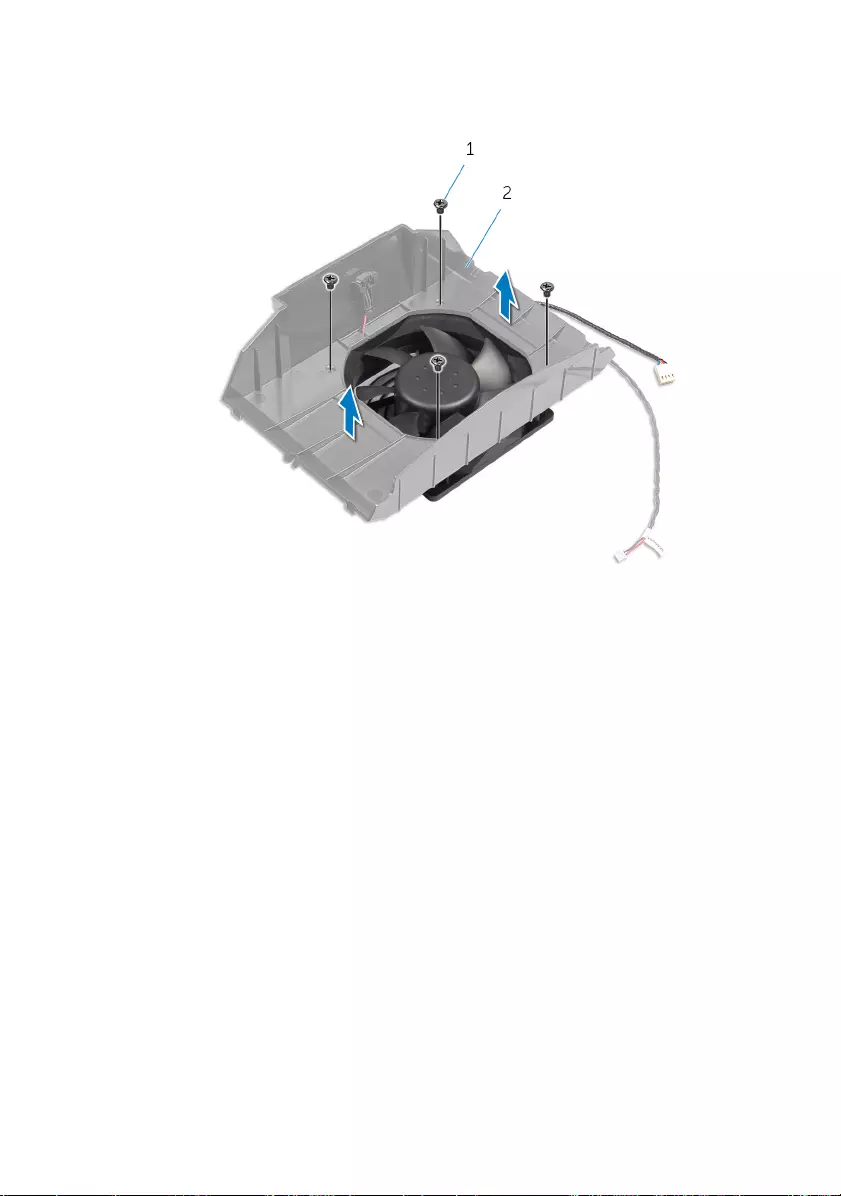
8 Lift and remove the fan shroud off the PCI fan.
Figure 43. Removing the PCI fan
1 screws (4) 2 fan shroud
106

Replacing the PCI fan
WARNING: Before working inside your computer, read the safety
information that shipped with your computer and follow the steps in
Before working inside your computer. After working inside your
computer, follow the instructions in After working inside your
computer. For more safety best practices, see the Regulatory
Compliance home page at www.dell.com/regulatory_compliance.
Procedure
1 Align the tabs on the fan shroud with the slots on the PCI fan.
2 Replace the four screws (M5x10) securing the fan shroud to the PCI fan.
3 Align the tabs on the PCI-fan shroud with the slots on the chassis and slide
the fan until it snaps into position.
4 Connect the PCI-fan cable and front-bezel heat-sensor cable to the
connectors on the system board.
5 Replace the two screws (M3x5.25) that secure the PCI fan to the chassis.
6 Place and align the screw holes on the graphics-card bracket with the screw
holes on the chassis.
7 Replace the four screws (#6-32x6) that secure the graphics-card bracket to
the chassis.
Post-requisites
1 Replace the full-length graphics cards.
2 Replace the left and right side-panels. See “Replacing the side panels”.
3 Replace the stability foot.
107

Removing the front-bezel heat
sensor cable
WARNING: Before working inside your computer, read the safety
information that shipped with your computer and follow the steps in
Before working inside your computer. After working inside your
computer, follow the instructions in After working inside your
computer. For more safety best practices, see the Regulatory
Compliance home page at www.dell.com/regulatory_compliance.
Prerequisites
1 Remove the stability foot.
2 Remove the left and right side-panels. See “Removing the side panels”.
3 Remove the full-length graphics cards.
4 Remove the PCI fan.
Procedure
NOTE: After removing the PCI fan, locate the sensor on the fan
shroud.
1 Lay the chassis on the right side.
108

2 Push the release tab and pry the front-bezel heat-sensor cable off the
chassis.
Figure 44. Removing the front-bezel heat-sensor cable
1 front-bezel heat-sensor cable 2 release tab
3 fan shroud
109

Replacing the front-bezel heat-
sensor cable
WARNING: Before working inside your computer, read the safety
information that shipped with your computer and follow the steps in
Before working inside your computer. After working inside your
computer, follow the instructions in After working inside your
computer. For more safety best practices, see the Regulatory
Compliance home page at www.dell.com/regulatory_compliance.
Procedure
1 Route the front-bezel heat-sensor cable through the bracket.
2 Align the tab on the front-bezel heat-sensor cable on the chassis.
3 Push the release tab on the front-bezel heat-sensor cable and press it into
place.
Post-requisites
1 Replace the PCI fan.
2 Replace the full-length graphics cards.
3 Replace the left and right side-panels. See “Replacing the side panels”.
4 Replace the stability foot.
110

Removing the processor liquid-
cooling assembly
WARNING: Before working inside your computer, read the safety
information that shipped with your computer and follow the steps in
Before working inside your computer. After working inside your
computer, follow the instructions in After working inside your
computer. For more safety best practices, see the Regulatory
Compliance home page at www.dell.com/regulatory_compliance.
Prerequisites
1 Remove the stability foot.
2 Remove the left and right side-panels. See “Removing the side panels”.
3 Remove the memory modules.
Procedure
WARNING: Despite having a plastic shield, the processor liquid-
cooling assembly may be very hot during normal operation. Ensure
that it had sufficient time to cool before you touch it.
CAUTION: To ensure maximum cooling for the processor, do not
touch the heat transfer areas on the processor liquid-cooling
assembly. The oils in your skin can reduce the heat transfer capability
of the thermal grease.
1 Lay the chassis on the right side.
2 In sequential order as indicated on the processor cooling-assembly pump,
loosen the captive screws that secure the processor liquid-cooling assembly
pump to the system board.
111

3 Remove the four screws (#6-32x6) that secure the processor liquid-cooling
assembly fan to the chassis.
Figure 45. Removing the processor liquid-cooling assembly
1 screws (4) 2 processor liquid-cooling
assembly fan
3 processor liquid-cooling
assembly pump
4 processor liquid-cooling
assembly fan cable
112
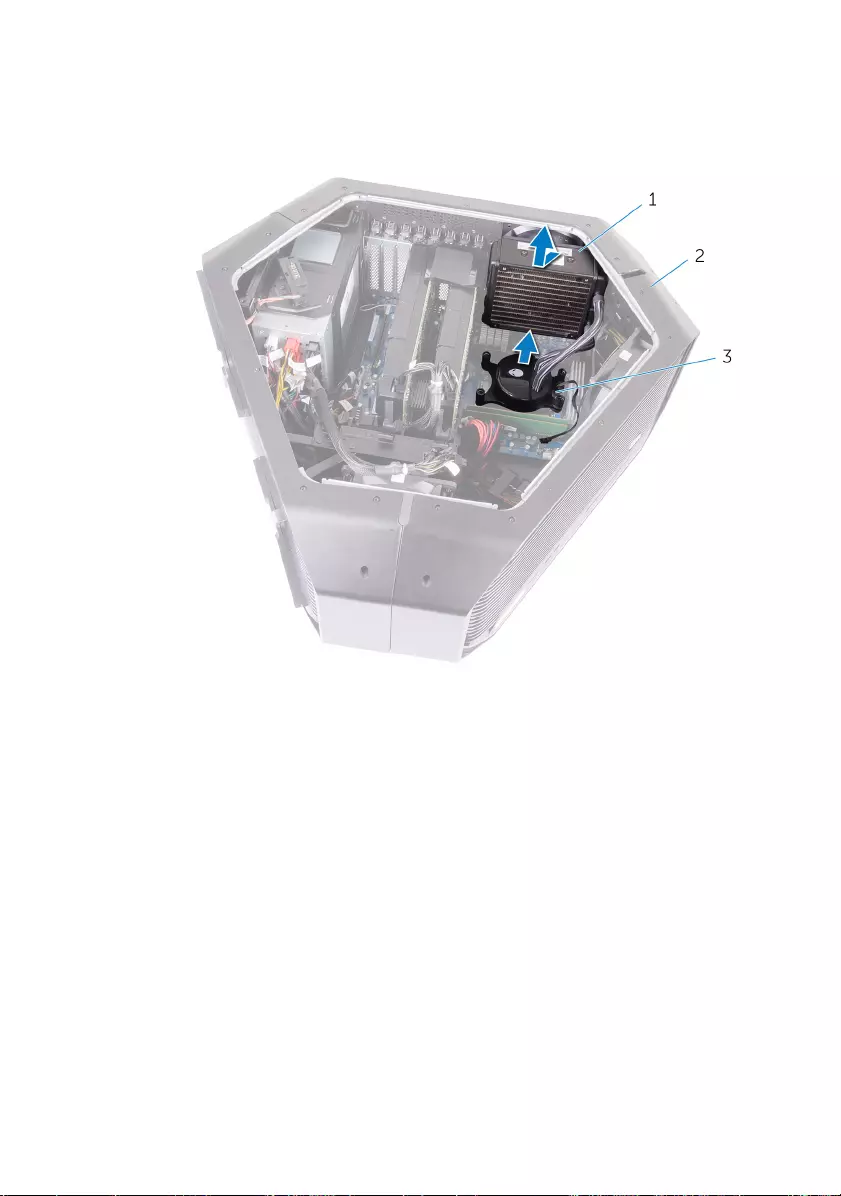
4 Slide and lift the processor liquid-cooling assembly fan and processor liquid-
cooling assembly pump out of the chassis.
Figure 46. Removing the processor liquid-cooling assembly
1 processor liquid-cooling
assembly fan
2 chassis
3 processor liquid-cooling
assembly pump
113

Replacing the processor liquid-
cooling assembly
WARNING: Before working inside your computer, read the safety
information that shipped with your computer and follow the steps in
Before working inside your computer. After working inside your
computer, follow the instructions in After working inside your
computer. For more safety best practices, see the Regulatory
Compliance home page at www.dell.com/regulatory_compliance.
Procedure
CAUTION: Incorrect alignment of the processor liquid-cooling
assembly can damage the system board and processor.
1 Apply thermal grease between the processor liquid-cooling assembly pump
and the processor.
NOTE: The original thermal grease can be reused if the original
processor and processor liquid-cooling are reinstalled together. If
either the processor or the processor liquid-cooling is replaced,
use the thermal grease provided in the kit to ensure that thermal
conductivity is achieved.
2 Hold the processor liquid-cooling assembly pump in one hand and
processor liquid-cooling assembly fan in another.
3 Align the processor liquid-cooling assembly pump over the processor, while
holding the processor liquid-cooling assembly fan outside the chassis and
secure the processor liquid-cooling assembly pump.
4 Connect the processor liquid-cooling assembly fan and the processor liquid-
cooling assembly pump-fan cable to the connectors on the system board.
5 Align the screw holes on the processor liquid-cooling assembly fan with the
screw holes on the chassis.
6 Replace the four screws (#6-32x6) that secure the processor liquid-cooling
assembly fan to the chassis.
114

7 In sequential order as indicated on the processor cooling-assembly, tighten
the captive screws that secure the processor liquid-cooling assembly to the
system board.
Post-requisites
1 Replace the memory modules.
2 Replace the left and right side-panels. See “Removing the side panels”.
3 Replace the stability foot.
115

Removing the processor
WARNING: Before working inside your computer, read the safety
information that shipped with your computer and follow the steps in
Before working inside your computer. After working inside your
computer, follow the instructions in After working inside your
computer. For more safety best practices, see the Regulatory
Compliance home page at www.dell.com/regulatory_compliance.
Prerequisites
1 Remove the stability foot.
2 Remove the left and right side-panels. See “Removing the side panels”.
3 Remove the processor liquid-cooling assembly fan.
Procedure
WARNING: The processor might still be hot after the computer is shut
down. Allow the processor to cool down before removing it.
1 Lay the computer on the left side.
2 Press down and push the left-release lever away from the processor to
release it from the securing tab.
3 Press down and push the right-release lever away from the processor to
release it from the securing tab.
4 Extend the right-release lever completely to open the processor cover.
CAUTION: When removing the processor, do not touch any of the
pins inside the socket or allow any objects to fall on the pins in
the socket.
116
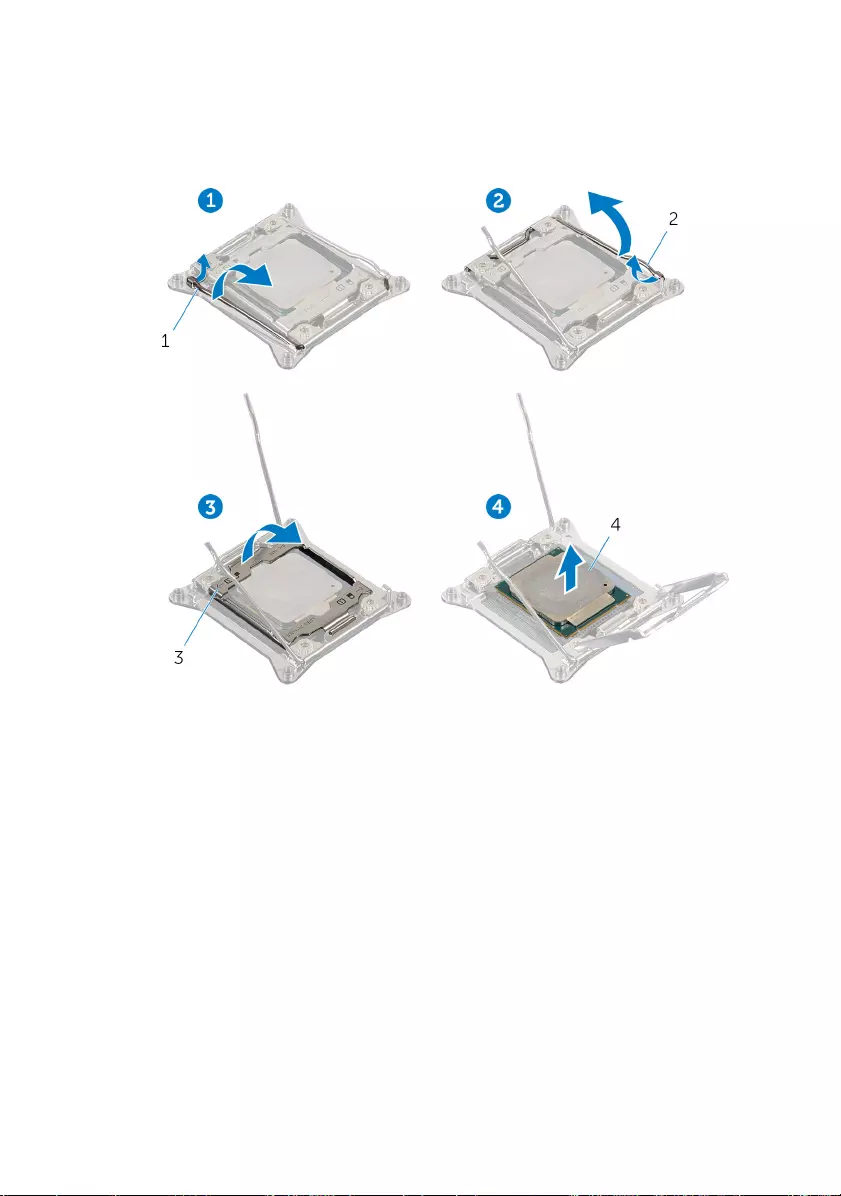
5 Open the processor cover and gently lift the processor from the processor
socket.
1 left release-lever 2 right release-lever
3 processor cover 4 processor
117

Replacing the processor
WARNING: Before working inside your computer, read the safety
information that shipped with your computer and follow the steps in
Before working inside your computer. After working inside your
computer, follow the instructions in After working inside your
computer. For more safety best practices, see the Regulatory
Compliance home page at www.dell.com/regulatory_compliance.
CAUTION: If either the processor or the heat sink is replaced, use the
thermal grease provided in the kit to ensure that thermal conductivity
is achieved.
NOTE: A new processor ships with a thermal pad in the package. In
some cases, the processor may ship with the thermal pad attached to
it.
Procedure
1 Ensure that the right-release lever is fully extended in the open position.
CAUTION: You must place the processor correctly in the
processor socket to avoid damage to the processor.
2 Align the pin-1 corner of the processor with the pin-1 corner of the processor
socket, and then place the processor in the processor socket.
NOTE: The pin-1 corner of the processor has a triangle that aligns
with the triangle on the pin-1 corner on the processor socket.
When the processor is properly seated, all four corners are
aligned at the same height. If one or more corners of the
processor are higher than the others, the processor is not seated
properly.
3 When the processor is fully seated in the socket, close the processor cover.
4 Press down and push the left-release lever. Place it under the tab on the
processor cover.
118

5 Press down and push the right-release lever. Place it under the tab on the
processor cover.
1 processor 2 processor pin-1 connector
3 processor cover 4 left release-lever
5 right release-lever
Post-requisites
1 Replace the processor liquid-cooling assembly fan.
2 Replace the left and right side-panels. See “Replacing the side panels”.
3 Replace the stability foot.
119

Removing the power-supply unit
WARNING: Before working inside your computer, read the safety
information that shipped with your computer and follow the steps in
Before working inside your computer. After working inside your
computer, follow the instructions in After working inside your
computer. For more safety best practices, see the Regulatory
Compliance home page at www.dell.com/regulatory_compliance.
Prerequisites
1 Remove the stability foot.
2 Remove the left and right side-panels. See “Removing the side panels”.
3 Remove the multiple graphics cards or full length graphics cards.
Procedure
NOTE: Note the routing of all cables as you remove them so that you
can route them correctly after you replace the power-supply unit.
1 Lay the chassis on the right side.
2 Press the release tabs on the power cables and disconnect all the cables
from the power-supply unit.
120

3 Remove the four screws (#6-32x6) that secure the power-supply unit to the
back of the chassis.
Figure 47. Removing the power-supply unit
1 power cable 2 power-supply unit
3 screws (4)
121

4 Lift the power-supply unit cover away from the chassis.
Figure 48. Removing the power-supply unit
1 power-supply unit 2 power-supply unit cover
122

5 Slide the power-supply unit out through the back of the chassis and remove
it from the computer.
Figure 49. Removing the power-supply unit
1 chassis 2 power-supply unit
6 Slide and remove the metal bracket from the power-supply unit.
123

Replacing the power-supply unit
WARNING: Before working inside your computer, read the safety
information that shipped with your computer and follow the steps in
Before working inside your computer. After working inside your
computer, follow the instructions in After working inside your
computer. For more safety best practices, see the Regulatory
Compliance home page at www.dell.com/regulatory_compliance.
Procedure
WARNING: The cables and ports on the back of the power-supply unit
are color-coded to indicate the different power wattage. Ensure that
you plug in the cable to the correct port. Failure to do so may result in
damaging the power-supply unit and/or system components.
1 Slide the power-supply unit into the metal bracket.
124

2 Press and hold the securing tab on the chassis and slide the power-supply
unit into the chassis until it snaps into position.
Figure 50. Replacing the power-supply unit
1 securing tab 2 power-supply unit
3 Align the notch on the power-supply unit cover with the tab on the chassis.
4 Slide the power-supply unit cover towards the tabs until it locks in place.
5 Replace the four screws (#6-32x6) that secure the power-supply unit to the
bezel.
6 Connect the power cable to the power-supply unit.
125

Removing the system board
WARNING: Before working inside your computer, read the safety
information that shipped with your computer and follow the steps in
Before working inside your computer. After working inside your
computer, follow the instructions in After working inside your
computer. For more safety best practices, see the Regulatory
Compliance home page at www.dell.com/regulatory_compliance.
NOTE: Your computer’s Service Tag is stored in the system board.
You must enter the Service Tag in the BIOS setup program after you
replace the system board.
NOTE: Replacing the system board removes any changes you have
made to the BIOS using the BIOS setup program. You must make the
appropriate changes again after you replace the system board.
NOTE: Before disconnecting the cables from the system board, note
the location of the connectors so that you can reconnect the cables
correctly after you replace the system board.
Prerequisites
1 Remove the left and right side-panels. See “Removing the side panels”.
2 Remove the top fan.
3 Remove the graphics card, multiple graphics cards, or full-length graphics
cards.
4 Remove the memory modules.
5 Remove the processor liquid-cooling assembly.
6 Remove the wireless card.
127

Procedure
NOTE: Note the routing of all cables as you remove them so that you
can route them correctly after you replace the system board. For
information on system-board connectors, see “system-board
components”.
1 Lay the chassis on the right side.
2 Disconnect all the cables connected to the system-board assembly.
3 Remove the nine screws (#6-32x6) that secure the system-board assembly
to the chassis.
128

Replacing the system board
WARNING: Before working inside your computer, read the safety
information that shipped with your computer and follow the steps in
Before working inside your computer. After working inside your
computer, follow the instructions in After working inside your
computer. For more safety best practices, see the Regulatory
Compliance home page at www.dell.com/regulatory_compliance.
NOTE: Your computer’s Service Tag is stored in the system board.
You must enter the Service Tag in the BIOS setup program after you
replace the system board.
NOTE: Replacing the system board removes any changes you have
made to the BIOS using the BIOS setup program. You must make the
appropriate changes again after you replace the system board.
Procedure
1 Replace the processor.
2 Align the ports on the system-board assembly with the slots on the chassis
and align the system-board assembly in place.
3 Replace the nine screws (#6-32x6) that secure the system-board assembly
to the chassis.
4 Route and connect the cables that you disconnected from the system-board
assembly.
NOTE: For information on system-board connectors, see
“system-board components”.
Post-requisites
1 Replace the processor liquid-cooling assembly fan.
2 Replace the memory modules.
3 Replace the graphics card, multiple graphics cards, or full-length graphics
cards.
4 Replace the top fan.
130

Removing the handle bars
WARNING: Before working inside your computer, read the safety
information that shipped with your computer and follow the steps in
Before working inside your computer. After working inside your
computer, follow the instructions in After working inside your
computer. For more safety best practices, see the Regulatory
Compliance home page at www.dell.com/regulatory_compliance.
Prerequisites
1 Remove the stability foot.
2 Remove the left and right side-panels. See “Removing the side panels”.
132

Procedure
1 Remove the seven screws (#6-32x6.5) that secure the rear handle-bar to
the left side of the chassis.
Figure 52. Removing the screws
1 screws (7) 2 chassis
3 rear-handle bar
2 Remove the seven screws (#6-32x6.5) that secure the rear handle-bar to
the right side of the chassis.
133

3 Press the rear-handle bar to release the securing tab and remove the rear-
handle bar.
Figure 53. Removing the rear-handle bar
1 screws (7) 2 rear-handle bar
3 chassis
134

4 Remove the seven screws (#6-32x6.5) that secure the front handle-bar to
the left side of the chassis.
Figure 54. Removing the screws
1 screws (7) 2 chassis
3 front-handle bar
5 Remove the seven screws (#6-32x6.5) that secure the front handle-bar to
the right side of the chassis.
135

6 Press the front-handle bar to release the securing tab and remove the front-
handle bar.
Figure 55. Removing the front-handle bar
1 screws (7) 2 front-handle bar
3 chassis
136

7 Remove the seven screws (#6-32x6.5) that secure the bottom handle-bar to
the left side of the chassis.
Figure 56. Removing the screws
1 screws (7) 2 bottom-handle bar
3 chassis
8 Remove the seven screws (#6-32x6.5) that secure the bottom handle-bar to
the right side of the chassis.
137
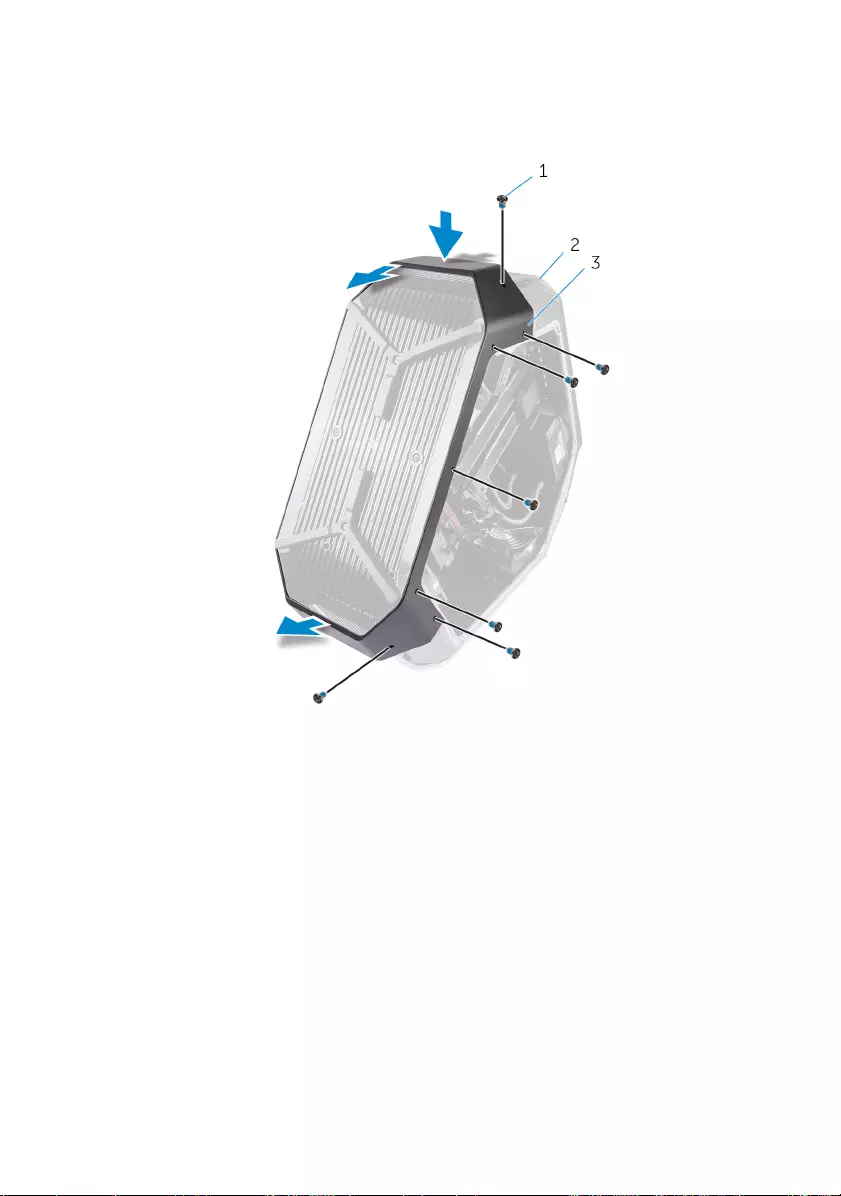
9 Press the bottom-handle bar to release the securing tab and remove the
bottom-handle bar.
Figure 57. Removing the bottom-handle bar
1 screws (7) 2 chassis
3 bottom-handle bar
138

Replacing the handle bars
WARNING: Before working inside your computer, read the safety
information that shipped with your computer and follow the steps in
Before working inside your computer. After working inside your
computer, follow the instructions in After working inside your
computer. For more safety best practices, see the Regulatory
Compliance home page at www.dell.com/regulatory_compliance.
Procedure
1 Align and place the bottom-handle bar on the slot and snap the bottom-
handle bar to the chassis.
2 Replace the seven screws (#6-32x6.5) that secure the bottom-handle bar to
the left side of the chassis.
3 Replace the seven screws (#6-32x6.5) that secure the bottom-handle bar to
the right side of the chassis.
4 Align and place the front-handle bar on the slot and snap the front-handle
bar to the chassis.
5 Replace the seven screws (#6-32x6.5) that secure the front-handle bar to
the left side of the chassis.
6 Replace the seven screws (#6-32x6.5) that secure the front-handle bar to
the right side of the chassis.
7 Align and place the rear-handle bar on the slot and snap the rear-handle bar
to the chassis.
8 Replace the seven screws (#6-32x6.5) that secure the rear-handle bar to
the left side of the chassis.
9 Replace the seven screws (#6-32x6.5) that secure the rear-handle bar to
the right side of the chassis.
Post-requisites
1 Replace the left and right side-panels. See “Replacing the side panels”.
2 Replace the stability foot.
139

Removing the front bezel
WARNING: Before working inside your computer, read the safety
information that shipped with your computer and follow the steps in
Before working inside your computer. After working inside your
computer, follow the instructions in After working inside your
computer. For more safety best practices, see the Regulatory
Compliance home page at www.dell.com/regulatory_compliance.
Prerequisites
1 Remove the stability foot.
2 Remove the left and right side-panels. See “Removing the side panels”.
3 Remove the handle bars.
140

Procedure
1 Remove the four screws (#6-32x6) that secure the front bezel to the bottom
and top of the chassis.
Figure 58. Removing the screws
1 screws (4) 2 front bezel
2 Remove the two screws (6-32x5.2) from inside, securing the front bezel to
the left side of the chassis.
3 Remove the screw (6-32x5.2) from inside, securing the front bezel to the
right side of the chassis.
141

4 Release the tabs from inside the chassis on the right side, securing the front
bezel to the chassis.
Figure 59. Removing the screws
1 chassis 2 tabs (2)
3 screws (3)
5 Pull the connector downwards and then disconnect the bottom tron light-
cables from the front bezel.
6 Pull the connector downwards and then disconnect the top tron light-cables
from the front bezel.
142

7 Pull the front bezel off the chassis.
Figure 60. Removing the front bezel
1 front bezel 2 tron-light cables
143

Replacing the front bezel
WARNING: Before working inside your computer, read the safety
information that shipped with your computer and follow the steps in
Before working inside your computer. After working inside your
computer, follow the instructions in After working inside your
computer. For more safety best practices, see the Regulatory
Compliance home page at www.dell.com/regulatory_compliance.
Procedure
1 Align the tabs from inside the chassis on the right and left side and place the
front bezel and snap it in place.
2 Connect the top tron light-cables to the front bezel.
3 Connect the bottom tron light-cables to the front bezel.
4 Replace the screw (6-32x5.2) from inside, securing the front bezel to the
right side of the chassis.
5 Replace the two screws (6-32x5.2) from inside, securing the front bezel to
the left side of the chassis.
6 Replace the four screws (#6-32x6) that secure the front bezel to the bottom
and top of the chassis.
Post-requisites
1 Replace the handle bars.
2 Replace the left and right side-panels. See “Replacing the side panels”.
3 Replace the stability foot.
144

Removing the optical-drive eject-
button board
WARNING: Before working inside your computer, read the safety
information that shipped with your computer and follow the steps in
Before working inside your computer. After working inside your
computer, follow the instructions in After working inside your
computer. For more safety best practices, see the Regulatory
Compliance home page at www.dell.com/regulatory_compliance.
Prerequisites
1 Remove the stability foot.
2 Remove the left and right side-panels. See “Removing the side panels”.
3 Remove the handle bars.
4 Remove the front bezel.
145

Procedure
1 Disconnect the optical-drive eject-button board cable from the I/O board.
Figure 61. Removing the optical-drive eject-button board cable
1 optical-drive eject-button
board cable
2 securing clip
3 I/O board
146

2 Open the securing clips which secure the optical-drive eject-button board
cable to the chassis.
Figure 62. Removing the optical-drive eject-button board cable
1 chassis 2 securing clips
3 Remove the two screws (#6-32x6) that secure the optical-drive eject-button
board to the chassis.
147

4 Remove the optical-drive eject-button board, along with the cable, off the
chassis.
Figure 63. Removing the optical-drive eject-button board
1 optical-drive eject-button
board
2 screws (2)
3 chassis
148

Replacing the optical-drive eject-
button board
WARNING: Before working inside your computer, read the safety
information that shipped with your computer and follow the steps in
Before working inside your computer. After working inside your
computer, follow the instructions in After working inside your
computer. For more safety best practices, see the Regulatory
Compliance home page at www.dell.com/regulatory_compliance.
Procedure
1 Align and place the optical-drive eject-button board, along with the cable on
the chassis.
2 Replace the two screws (#6-32x6) that secure the optical-drive eject-button
board to the chassis.
3 Secure the optical-drive eject-button board cable to the chassis using the
securing clips.
4 Connect the optical-drive eject-button board cable to the I/O board.
Post-requisites
1 Replace the front bezel.
2 Replace the handle bars.
3 Replace the left and right side-panels. See “Replacing the side panels”.
4 Replace the stability foot.
149

Removing the rear bezel
WARNING: Before working inside your computer, read the safety
information that shipped with your computer and follow the steps in
Before working inside your computer. After working inside your
computer, follow the instructions in After working inside your
computer. For more safety best practices, see the Regulatory
Compliance home page at www.dell.com/regulatory_compliance.
Prerequisites
1 Remove the stability foot.
2 Remove the left and right side-panels. See “Removing the side panels”.
3 Follow the procedure from step 1 to step 3 in Removing the handle bars to
remove the rear handle bar.
150

Procedure
1 Disconnect the rear I/O accessibility lighting cable from the I/O board.
Figure 64. Removing the rear I/O accessibility lighting cable
1 securing clip 2 I/O board
3 rear I/O accessibility lighting
cable
2 Open the securing clip which secures the rear I/O accessibility lighting cable
to the chassis.
151

3 Remove the rear I/O accessibility lighting cable through the slot on the
chassis.
Figure 65. Removing the rear I/O accessibility lighting cable
1 chassis 2 securing clip
3 rear I/O accessibility lighting
cable
4 slot
4 Remove the four screws (#6-32x6) that secure the power-supply unit to the
back of the chassis.
5 Lift the power-supply unit cover away from the chassis.
152

6 Remove the rear I/O accessibility lighting cable from the routing guides on
the chassis.
Figure 66. Removing the rear I/O accessibility lighting cable
1 rear bezel 2 power-supply unit cover
3 screws (4) 4 rear I/O accessibility
lighting cable
5 routing guides (2) 6 chassis
153
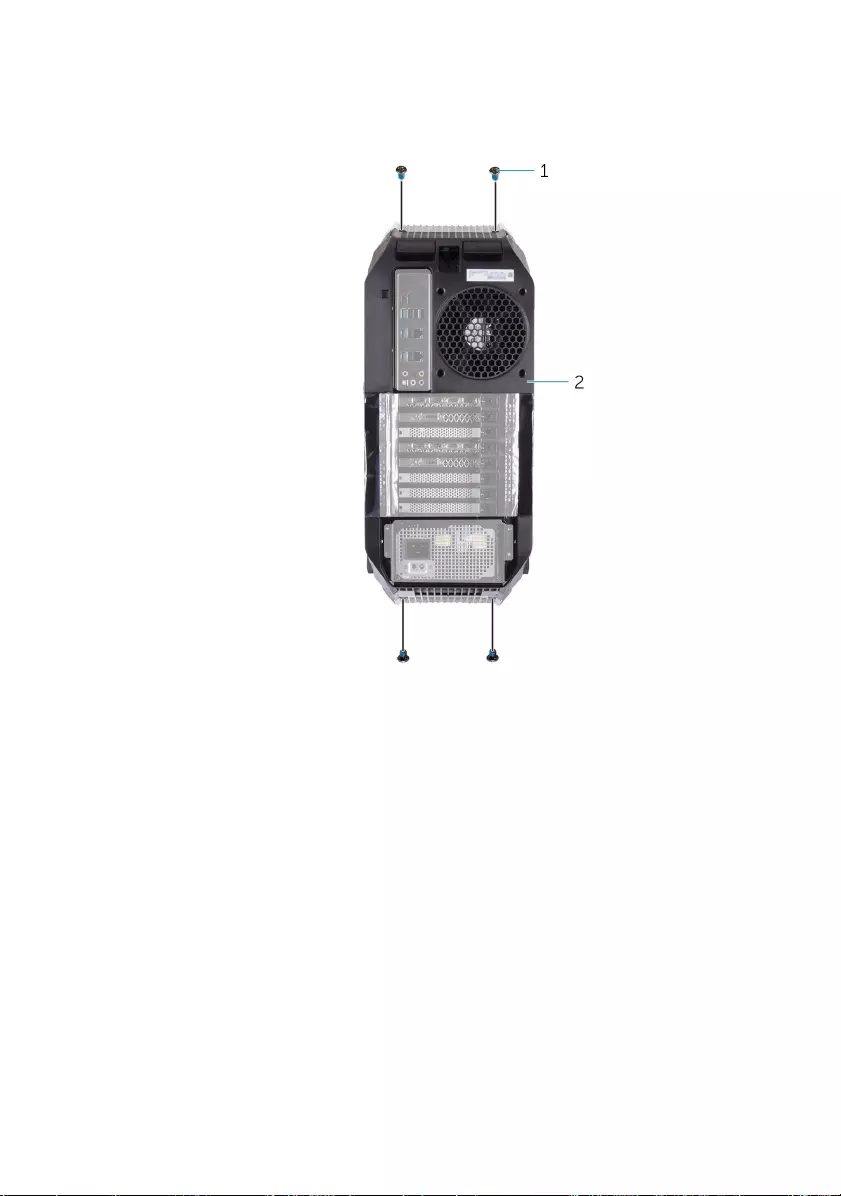
7 Remove the four screws (#6-32x6) that secure the rear bezel to the top and
bottom of the chassis.
Figure 67. Removing the rear bezel
1 screws (4) 2 rear bezel
8 Remove the two screws (M3x5) from inside, that secure the rear bezel to
the left side and right side of the chassis.
154

9 Release the tabs from inside the chassis on the right side and left side,
securing the rear bezel to the chassis.
Figure 68. Removing the rear bezel
1 chassis 2 tabs (6)
3 screws (2)
155

10 Remove the rear bezel from the chassis and remove the rear I/O
accessibility lighting cable from the slot on the chassis.
Figure 69. Removing the rear bezel
1 rear bezel 2 chassis
156

Replacing the rear bezel
WARNING: Before working inside your computer, read the safety
information that shipped with your computer and follow the steps in
Before working inside your computer. After working inside your
computer, follow the instructions in After working inside your
computer. For more safety best practices, see the Regulatory
Compliance home page at www.dell.com/regulatory_compliance.
Procedure
1 Route the rear I/O accessibility lighting cable through the slot on the
chassis.
2 Align the tabs from inside the chassis on the right side and left side,
securing the rear bezel to the chassis and snap it in place.
3 Replace the two screws (M3x5) from inside, that secure the rear bezel to the
right side and left side of the chassis.
4 Replace the four screws (#6-32x6) that secures the rear bezel to the top and
bottom of the chassis.
5 Route the rear I/O accessibility lighting cable through the routing guides on
the chassis.
6 Align and place the power-supply cover on the chassis.
7 Replace the four screws (#6-32x6) that secure the power-supply unit to the
back of the chassis.
8 Insert the rear I/O accessibility lighting cable through the slot on the chassis.
9 Secure the rear I/O accessibility lighting cable to the chassis using the
securing clip.
10 Connect the rear I/O accessibility lighting cable to the I/O board.
Post-requisites
1 Follow the procedure from step 7 to step 9 in Replacing the handle bars to
replace the rear handle bar.
2 Replace the left and right side-panels. See “Replacing the side panels”.
3 Replace the stability foot.
157

Removing the base panel
WARNING: Before working inside your computer, read the safety
information that shipped with your computer and follow the steps in
Before working inside your computer. After working inside your
computer, follow the instructions in After working inside your
computer. For more safety best practices, see the Regulatory
Compliance home page at www.dell.com/regulatory_compliance.
Prerequisites
1 Remove the stability foot.
2 Remove the left and right side-panels. See “Removing the side panels”.
3 Remove the battery case.
4 Remove the hard drive (HDD1).
158

Procedure
CAUTION: If the front bezel and rear bezel have been removed, place
the chassis carefully on a flat surface to avoid damaging the I/O ports.
1 Remove the four screws (#6-32x6) that secure the base panel to the
chassis.
Figure 70. Removing the base panel
1 screws (4) 2 base panel
2 Remove the three screws (#6-32x6) from inside, securing the base panel to
the left side of the chassis.
159
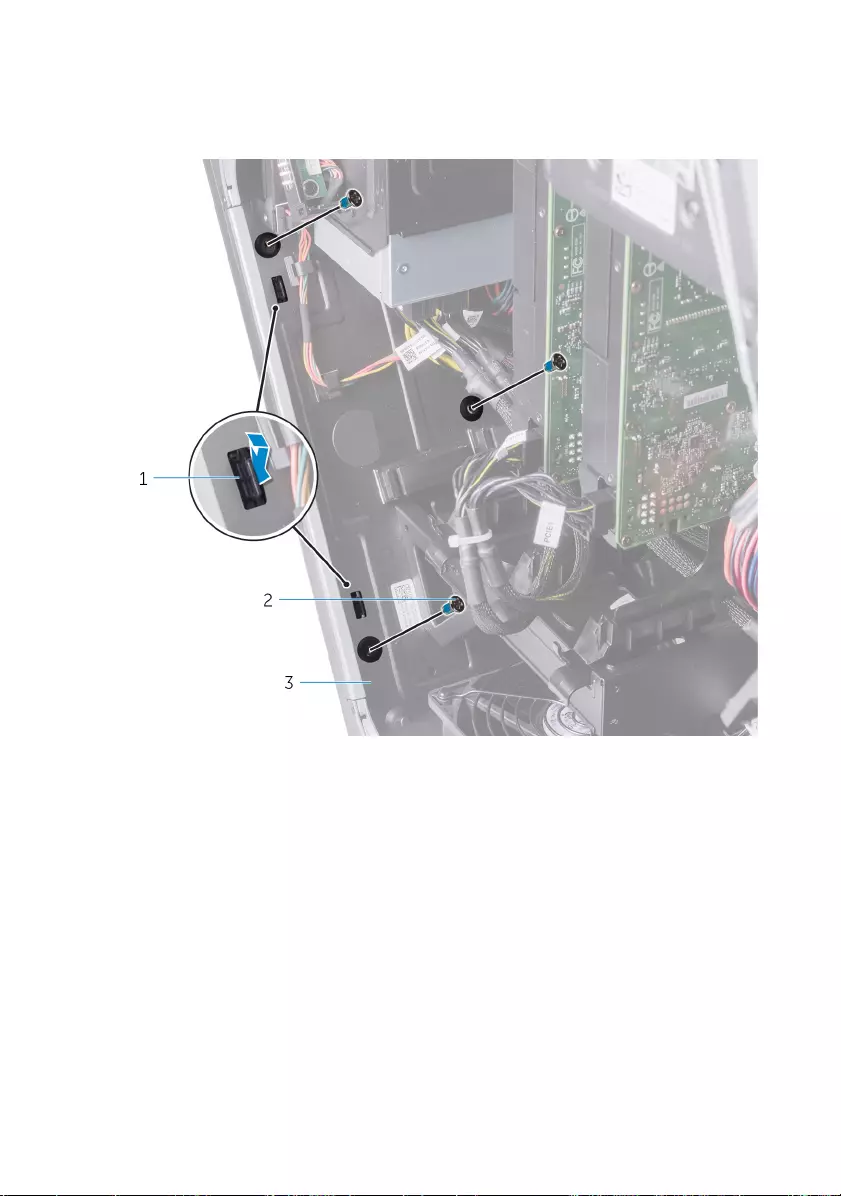
3 Release the tabs from inside the chassis on the left side, securing the base
panel to the left side of the chassis.
Figure 71. Removing the base panel
1 tabs (2) 2 screws (3)
3 chassis
4 Remove the two screws (#6-32x6) from inside, securing the base panel to
the right side of the chassis.
160

5 Release the tabs from inside the chassis on the right side, securing the base
panel to the right side of the chassis.
Figure 72. Removing the base panel
1 screws (2) 2 tabs (2)
3 chassis
161

6 Remove the base panel from the chassis.
Figure 73. Removing the base panel
1 base panel 2 chassis
162

Replacing the base panel
WARNING: Before working inside your computer, read the safety
information that shipped with your computer and follow the steps in
Before working inside your computer. After working inside your
computer, follow the instructions in After working inside your
computer. For more safety best practices, see the Regulatory
Compliance home page at www.dell.com/regulatory_compliance.
Procedure
1 Align the tabs from inside the chassis on the right side and left side,
securing the base panel to the chassis and snap it in place.
2 Replace the two screws ((#6-32x6) from inside, securing the base panel to
the right side of the chassis.
3 Replace the three screws ((#6-32x6) from inside, securing the base panel to
the left side of the chassis.
4 Replace the four screws (#6-32x6) that secure the base panel to the
chassis.
Post-requisites
1 Replace the hard drive (HDD1).
2 Replace the battery case.
3 Replace the left and right side-panels. See “Replacing the side panels”.
4 Replace the stability foot.
163

Removing the top tron-lighting
cable
WARNING: Before working inside your computer, read the safety
information that shipped with your computer and follow the steps in
Before working inside your computer. After working inside your
computer, follow the instructions in After working inside your
computer. For more safety best practices, see the Regulatory
Compliance home page at www.dell.com/regulatory_compliance.
Prerequisites
1 Remove the stability foot.
2 Remove the left and right side-panels. See “Removing the side panels”.
3 Remove the handle bars.
4 Remove the front bezel.
5 Remove the rear bezel.
6 Remove the base panel.
Procedure
1 Disconnect the top tron-lighting cables from the logo board.
164

2 Remove the top tron-lighting cables from the routing-guides on the chassis.
Figure 74. Removing the top tron-lighting cables
1 chassis 2 tron-lighting cables
3 logo board 4 routing guides
165

3 Peel the tape that secures the top tron-lighting cables to the chassis and lift
the top tron-lighting cables.
Figure 75. Removing the top tron-lighting cables
1 chassis 2 tape
3 top tron-lighting cables
166

Replacing the top tron-lighting
cable
WARNING: Before working inside your computer, read the safety
information that shipped with your computer and follow the steps in
Before working inside your computer. After working inside your
computer, follow the instructions in After working inside your
computer. For more safety best practices, see the Regulatory
Compliance home page at www.dell.com/regulatory_compliance.
Procedure
1 Align and place the top tron-lighting cables on the chassis.
2 Adhere the tape that secures the top tron-lighting cables to the chassis.
3 Route the top tron-lighting cables through the routing-guides on the chassis.
4 Connect the top tron-lighting cables to the logo board.
Post-requisites
1 Replace the base panel.
2 Replace the rear bezel.
3 Replace the front bezel.
4 Replace the handle bars.
5 Replace the left and right side-panels. See “Replacing the side panels”.
6 Replace the stability foot.
167

Removing the bottom tron-
lighting cable
WARNING: Before working inside your computer, read the safety
information that shipped with your computer and follow the steps in
Before working inside your computer. After working inside your
computer, follow the instructions in After working inside your
computer. For more safety best practices, see the Regulatory
Compliance home page at www.dell.com/regulatory_compliance.
Prerequisites
1 Remove the stability foot.
2 Remove the left and right side-panels. See “Removing the side panels”.
3 Remove the full-length graphics cards.
4 Remove the PCI fan.
5 Remove the handle bars.
6 Remove the front bezel.
7 Remove the rear bezel.
8 Remove the base panel.
Procedure
1 Disconnect the bottom tron-lighting cables from the logo board.
2 Open the securing clip which secures the bottom tron-lighting cables to the
chassis.
168

3 Remove the bottom tron-lighting cables from the routing guide on the
chassis.
Figure 76. Removing the bottom tron-lighting cables
1 securing clip 2 routing guide
3 logo board 4 tron-lighting cables
169
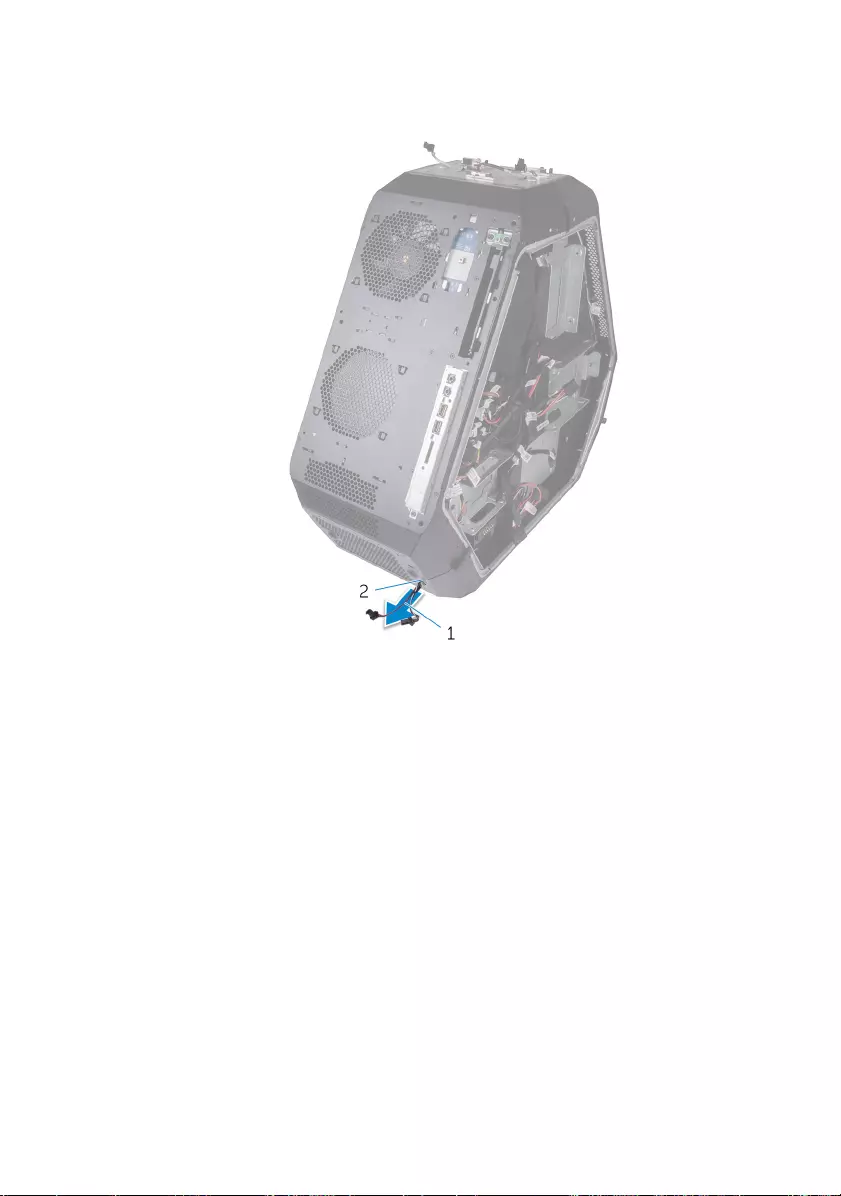
4 Remove the bottom tron-lighting cables from the slot on the chassis.
Figure 77. Removing the bottom tron-lighting cables
1 top tron-lighting cables 2 slot
170

Replacing the bottom tron-
lighting cable
WARNING: Before working inside your computer, read the safety
information that shipped with your computer and follow the steps in
Before working inside your computer. After working inside your
computer, follow the instructions in After working inside your
computer. For more safety best practices, see the Regulatory
Compliance home page at www.dell.com/regulatory_compliance.
Procedure
1 Route the bottom tron-lighting cables through the slot on the chassis.
2 Route the bottom tron-lighting cables through the routing guide on the
chassis.
3 Secure the bottom tron-lighting cables to the chassis using the securing clip.
4 Connect the bottom tron-lighting cables to the logo board.
Post-requisites
1 Replace the base panel.
2 Replace the rear bezel.
3 Replace the front bezel.
4 Replace the handle bars.
5 Replace the PCI fan.
6 Replace the full-length graphics cards.
7 Replace the left and right side-panels. See “Replacing the side panels”.
8 Replace the stability foot.
171

Removing the antenna cables
WARNING: Before working inside your computer, read the safety
information that shipped with your computer and follow the steps in
Before working inside your computer. After working inside your
computer, follow the instructions in After working inside your
computer. For more safety best practices, see the Regulatory
Compliance home page at www.dell.com/regulatory_compliance.
Prerequisites
1 Remove the stability foot.
2 Remove the left and right side-panels. See “Removing the side panels”.
3 Remove the handle bars.
4 Remove the memory modules.
5 Remove the full-length graphics cards.
6 Remove the wireless card.
7 Remove the processor liquid-cooling assembly.
8 Remove the system board.
9 Remove the rear bezel.
Procedure
1 Disconnect the antenna cables from the wireless card.
172

2 Remove the gray antenna cable from the routing guide on the chassis.
Figure 78. Removing the antenna cables
1 antenna cables 2 wireless card
3 routing guide 4 chassis
173

3 Remove the antenna cables from the routing guides on the chassis.
Figure 79. Removing the antenna cables
1 chassis 2 routing guides
174

4 Remove the antenna cables from the routing guide on the chassis and slide
the antenna cable through the slot on the chassis.
Figure 80. Removing the antenna cables
1 antenna cables 2 routing guide
3 slot
5 Peel the tape that secures the antenna cables to the chassis.
6 Remove the six screws (#6-32x6) that secure the antenna cables to the
chassis.
175

7 Pull the antenna cables from the slot on the chassis and remove.
Figure 81. Removing the antenna cables
1 screws 2 slot
3 chassis 4 antenna cables
176

Replacing the antenna cables
WARNING: Before working inside your computer, read the safety
information that shipped with your computer and follow the steps in
Before working inside your computer. After working inside your
computer, follow the instructions in After working inside your
computer. For more safety best practices, see the Regulatory
Compliance home page at www.dell.com/regulatory_compliance.
Procedure
1 Place the antenna cables in place and slide the antenna cables through the
slot on the chassis.
2 Replace the six screws (#6-32x6) that secure the antenna cables to the
chassis.
3 Adhere the tape that secures the antenna cables to the chassis.
4 Route the antenna cable through the slot on the chassis and then through
the routing guides on the chassis.
5 Route the gray antenna cable through the routing guide on the chassis.
6 Connect the antenna cables from the wireless card.
Post-requisites
1 Replace the rear bezel.
2 Replace the system board.
3 Replace the processor liquid-cooling assembly.
4 Replace the wireless card.
5 Replace the full-length graphics cards.
6 Replace the memory modules.
7 Replace the handle bars.
8 Replace the left and right side-panels. See “Replacing the side panels”.
9 Replace the stability foot.
177

Downloading drivers
Downloading the audio driver
1 Turn on your computer.
2 Go to www.dell.com/support.
3 Click Product Support, enter the Service Tag of your computer, and then
click Submit.
NOTE: If you do not have the Service Tag, use the auto-detect
feature or manually browse for your computer model.
4 Click Drivers & Downloads → Find it myself.
5 Scroll down the page and expand Audio.
6 Click Download to download the audio driver for your computer.
7 After the download is complete, navigate to the folder where you saved the
audio driver file.
8 Double-click the audio driver file icon and follow the instructions on the
screen to install the driver.
Downloading the graphics driver
1 Turn on your computer.
2 Go to www.dell.com/support.
3 Click Product Support, enter the Service Tag of your computer, and then
click Submit.
NOTE: If you do not have the Service Tag, use the auto-detect
feature or manually browse for your computer model.
4 Click Drivers & downloads → Find it myself.
5 Scroll down the page and expand Video.
6 Click Download to download the graphics driver for your computer.
7 After the download is complete, navigate to the folder where you saved the
graphics driver file.
8 Double-click the graphics driver file icon and follow the instructions on the
screen to install the driver.
178

Downloading the USB 3.0 driver
1 Turn on your computer.
2 Go to www.dell.com/support.
3 Click Product Support, enter the Service Tag of your computer, and then
click Submit.
NOTE: If you do not have the Service Tag, use the auto-detect
feature or manually browse for your computer model.
4 Click Drivers & Downloads → Find it myself.
5 Scroll down the page and expand Chipset.
6 Click Download to download the USB 3.0 driver for your computer.
7 After the download is complete, navigate to the folder where you saved USB
3.0 driver file.
8 Double-click the USB 3.0 driver file icon and follow the instructions on
screen to install the driver.
Downloading the Wi-Fi driver
1 Turn on the computer.
2 Go to www.dell.com/support.
3 Click Product support, enter the Service Tag of your computer, and then
click Submit.
NOTE: If you do not have the Service Tag, use the auto-detect
feature or manually browse for your computer model.
4 Click Drivers & downloads → Find it myself.
5 Scroll down the page and expand Network.
6 Click Download to download the Wi-Fi driver for your computer.
7 After the download is complete, navigate to the folder where you saved the
Wi-Fi driver file.
8 Double-click the driver file icon and follow the instructions on the screen.
Downloading the chipset driver
1 Turn on your computer.
179

2 Go to www.dell.com/support.
3 Click Product Support, enter the Service Tag of your computer, and then
click Submit.
NOTE: If you do not have the Service Tag, use the auto-detect
feature or manually browse for your computer model.
4 Click Drivers & downloads → Find it myself.
5 Scroll down the page and expand Chipset.
6 Click Download to download the appropriate chipset driver for your
computer.
7 After the download is complete, navigate to the folder where you saved the
chipset driver file.
8 Double-click the chipset driver file icon and follow the instructions on the
screen to install the driver.
Downloading the network driver
1 Turn on your computer.
2 Go to www.dell.com/support.
3 Click Product support enter the Service Tag of your computer and click
Submit.
NOTE: If you do not have the Service Tag, use the auto-detect
feature or manually browse for your computer model.
4 Click Drivers & downloads → Find it myself.
5 Scroll down the page and expand Network.
6 Click Download to download the network driver for your computer.
7 Save the file, and after the download is complete, navigate to the folder
where you saved the network driver file.
8 Double-click the network driver file icon and follow the instructions on
screen.
180

BIOS setup program
Boot Sequence
Boot Sequence allows you to bypass the System Setup–defined boot device
order and boot directly to a specific device (for example: optical drive or hard
drive). During the Power-on Self Test (POST), when the Dell logo appears. you
can:
• Access System Setup by pressing F2 key
• Bring up the one-time boot menu by pressing F12 key
The one-time boot menu displays the devices that you can boot from including
the diagnostic option. The boot menu options are:
• Removable Drive (if available)
• STXXXX Drive
NOTE: XXX denotes the SATA drive number.
• Optical Drive (if available)
• Diagnostics
NOTE: Choosing Diagnostics, will display the ePSA diagnostics
screen.
The boot sequence screen also displays the option to access the System Setup
screen.
Navigation keys
NOTE: For most of the System Setup options, changes that you make
are recorded but do not take effect until you restart the system.
Keys Navigation
Up arrow Moves to the previous field.
Down arrow Moves to the next field.
181

Keys Navigation
Enter Selects a value in the selected field (if applicable) or
follow the link in the field.
Spacebar Expands or collapses a drop‐down list, if applicable.
Tab Moves to the next focus area.
NOTE: For the standard graphics browser only.
Esc Moves to the previous page until you view the main
screen. Pressing Esc in the main screen displays a
message that prompts you to save any unsaved changes
and restarts the system.
BIOS overview
CAUTION: Unless you are an expert computer user, do not change the
settings in the BIOS Setup program. Certain changes can make your
computer work incorrectly.
NOTE: Before you change BIOS Setup program, it is recommended
that you write down the BIOS Setup program screen information for
future reference.
Use the BIOS Setup program for the following purposes:
• Get information about the hardware installed in your computer, such as the
amount of RAM and the size of the hard drive.
• Change the system configuration information.
• Set or change a user-selectable option, such as the user password, type of
hard drive installed, and enabling or disabling base devices.
Entering BIOS setup program
1 Turn on (or restart) your computer.
182

2 During POST, when the DELL logo is displayed, watch for the F2 prompt to
appear, and then press F2 immediately.
NOTE: The F2 prompt indicates that the keyboard is initialized.
This prompt can appear very quickly, so you must watch for it,
and then press F2. If you press F2 before the F2 prompt, this
keystroke is lost. If you wait too long and the operating system
logo appears, continue to wait until you see the desktop. Then,
turn off your computer and try again.
System setup options
NOTE: Depending on your computer and its installed devices, the
items listed in this section may or may not appear.
Table 3. System setup options—Main menu
Main
System Date Displays the current date in mm/dd/
yyyy format.
System Time Displays the current time in
hh:mm:ss format.
BIOS Information
BIOS Version Displays the BIOS version number.
Build Date Displays the BIOS release date.
Product Information
Product Name Displays the product name. Default:
Alienware Area-51 R4.
Set Service Tag Allows you to enter the service tag
of your computer.
Asset Tag Displays the asset tag of your
computer.
ME Information
ME Firmware version Displays the Management Engine
firmware version.
EC Information
183

Main
EC Firmware Version Displays the Embedded Controller
firmware version.
Memory Information
Total Memory Displays the total computer memory
installed.
Memory Available Displays the amount of memory
available on the computer.
Memory Technology Displays the type of memory
technology used.
Memory Speed Displays the memory speed.
CPU Information
Processor Type Displays the processor type
Processor ID Displays the processor identification
code.
CPU Speed Displays the CPU speed.
Cache L2 Displays the processor L2 cache
size.
Cache L3 Displays the processor L3 cache
size.
Device Information
First HDD Displays the first HDD device
information.
PCIe SSD-1 Displays the PCIe SSD device
information.
Table 4. System setup options—Advanced menu
Advanced
Advanced BIOS Features
BIOS Recovery via Hard Drive Allows you to store the recovery image
file on the primary hard drive. Default:
Enabled.
184

Advanced
BIOS Auto-Recovery Enable the user to recover from certain
corrupted BIOS conditions from a
recovery file on the user primary hard
drive. Default: Disabled.
Always Perform Integrity Check Allows you to perform the Integrity
check. Default: Disabled.
CPU configuration
Hyper-threading Technology Enable or disable HyperThreading in
the processor. Default: Enabled.
Intel (R) SpeedStep (tm) Enable or disable Intel Speedstep
Technology. Default: Enabled.
NOTE: If enabled, the processor
clock speed and core voltage
are adjusted dynamically based
on the processor load.
Virtualization Allows you to enable or disable the Intel
Virtualization technology. Default:
Enabled
VT for Direct I/O Specify whether a Virtual Machine
Monitor (VMM) can utilize the additional
hardware capabilities provided by Intel
Virtualization Technology for Direct I/O.
Default: Enabled.
Active Processor Cores
Integrated Devices
Front USB Port Allows you to enable or disable the front
USB ports. Default: Enabled.
Rear USB Port Allows you to enable or disable the rear
USB ports. Default: Enabled.
ASMedia XHC Controller Allows you to enable or disable the
XHC controller. Default: Enabled.
HD Audio Allows you to enable or disable the
integrated audio controller. Default:
Enabled.
185

Advanced
Integrated NIC1 Allows you to enable or disable the
NIC1. Default: Enabled.
Integrated NIC2 Allows you to enable or disable the
NIC2. Default: Enabled.
Pxe Option Allows you to enable or disable the boot
option for legacy network devices.
Default: Disabled.
SATA Mode Allows you to configure the operating
mode of the integrated SATA hard drive
controller.
Default: Inte Smart Response
Technology.
PCIE GEN3 Allows you to enable or disable the
PCIE GEN3. Default: Disabled.
Power Management Setup
AC Recovery Sets what action the computer takes
when power is restored. Default: Last
State.
Deep Sleep Control Allows you to define the controls when
Deep Sleep is enabled. Default:
Enabled in S5 Only.
Auto Power On Enable to set the computer to turn on
automatically every day or on a
preselected date and time. This option
can be configured only if the Auto On
Time is set to Everyday, Weekdays, or
Selected Days.
Default: Disabled.
Numlock Key Enable or disable Numlock.
Default: Enable Numlock.
186

Table 5. System setup options—OC menu
OC
Intel CPU Allows you to set OC mode and
Custom Pstate0 for the CPU.
Intel Memory Allows you to set the overclocking.
Table 6. System setup options—Security menu
Security
Unlock Setup Displays if the setup status is
unlocked.
Admin Password Allows you to set the administrator
password. The administrator
password controls access to the
system setup utility.
System Password Allows you to set the system
password. The system password
controls access to the computer at
boot.
HDD Password Status Displays if the HDD password is
clear or set.
Default: Not set.
HDD1 Password Status Displays if the HDD password is
clear or set.
Default: Not set.
HDD2 Password Status Displays if the HDD password is
clear or set.
Default: Not set.
HDD3 Password Status Displays if the HDD password is
clear or set.
Default: Not set.
Password Change Allows you to permit or deny system
password or HDD password
changes. Default: Permitted
187

Security
Computrace Enable or disable the BIOS module
interface of the optional Computrace
Service from Absolute Software.
Firmware TPM Enable or disable the firmware TPM.
Default: Enabled.
UEFI Firmware Capsule Updates Enable or disable BIOS updates
through UEFI capsule update
packages.
Default: Enabled.
Table 7. System setup options—Boot menu
Boot
Boot Configuration
Wait for ‘F1’ If Error Allows you to enable or disable the
F1 screen. Default: All, but KB.
Secure Boot Control Allows you to enable or disable the
secure boot control. Default:
Disabled.
Load Legacy OPROM Default: Enabled.
Set Boot Priority
Boot List Option Allows you to select the boot list
option.
Default: Legacy.
USB Boot Support Allows you to enable or disable
USB Boot support. Default:
Enabled.
1st Boot Allows you to enable or disable the
1st boot device. Default: Hard Disk.
2nd Boot Allows you to enable or disable the
2nd boot device. Default: USB Hard
Disk.
3rd Boot Allows you to enable or disable the
3rd boot device. Default: CD/DVD.
188

Boot
4th Boot Allows you to enable or disable the
4th boot device. Default: Floppy.
5th Boot Allows you to enable or disable the
5th boot device. Default: Network.
Table 8. System setup options—Exit menu
Save & Exit
Save Changes and Reset Allows you to exit system setup and
save your changes.
Discard Changes and Reset Allows you to exit system setup and
load previous values for all system
setup options.
Restore Defaults Allows you to load default values for
all system setup options.
System and setup password
You can create a system password and a setup password to secure your
computer.
Password type Description
System password Password that you must enter to log on to your system.
Setup password Password that you must enter to access and make
changes to the BIOS settings of your computer.
CAUTION: The password features provide a basic level of security for
the data on your computer.
CAUTION: Anyone can access the data stored on your computer if it
is not locked and left unattended.
NOTE: Your computer is shipped with the system and setup
password feature is disabled.
Assigning a system password and setup password
You can assign a new System Password only when the status is in Not Set.
189

To enter the system setup, press F2 immediately after a power-on or re-boot.
1 In the System BIOS or System Setup screen, select Security and press
Enter.
The Security screen is displayed.
2 Select System Password and create a password in the Enter the new
password field.
Use the following guidelines to assign the system password:
– A password can have up to 32 characters.
– The password can contain the numbers 0 through 9.
– Only lower case letters are valid, upper case letters are not allowed.
– Only the following special characters are allowed: space, (”), (+), (,), (-),
(.), (/), (;), ([), (\), (]), (`).
3 Type the system password that you entered earlier in the Confirm new
password field and click OK.
4 Press Esc and a message prompts you to save the changes.
5 Press Y to save the changes.
The computer reboots.
Deleting or changing an existing system and/or setup
password
Ensure that the Password Status is Unlocked (in the System Setup) before
attempting to delete or change the existing System and/or Setup password. You
cannot delete or change an existing System or Setup password, if the Password
Status is Locked.
To enter the System Setup, press F2 immediately after a power-on or reboot.
1 In the System BIOS or System Setup screen, select System Security and
press Enter.
The System Security screen is displayed.
2 In the System Security screen, verify that Password Status is Unlocked.
3 Select System Password, alter or delete the existing system password and
press Enter or Tab.
190

4 Select Setup Password, alter or delete the existing setup password and
press Enter or Tab.
NOTE: If you change the System and/or Setup password, re-enter
the new password when promoted. If you delete the System
and/or Setup password, confirm the deletion when promoted.
5 Press Esc and a message prompts you to save the changes.
6 Press Y to save the changes and exit from System Setup.
The computer reboots.
Clearing Forgotten Passwords
WARNING: Before working inside your computer, read the safety
information that shipped with your computer and follow the steps in
Before working inside your computer. After working inside your
computer, follow the instructions in After working inside your
computer. For more safety best practices, see the Regulatory
Compliance home page at www.dell.com/regulatory_compliance.
1 Lay the chassis on the left side.
2 Remove the stability foot
3 Remove the left and right side-panels. See "Removing the side panels”.
4 Locate the password reset jumper (PASSWORD_CLR1) on the system
board. See “system-board components”.
5 Remove the jumper plug from pins 2 and 3 and fix it on pins 1 and 2.
6 Wait for approximately five seconds to clear the password setting.
191

7 Remove the jumper plug from pins 1 and 2 and replace it on pins 2 and 3.
Figure 82. Clearing forgotten passwords
1 pin 1 2 pin 2
3 pin 3 4 jumper plug
8 Replace the left and right side panels. See "Replacing the side panels”.
9 Replace the stability foot.
Clearing CMOS Settings
WARNING: Before working inside your computer, read the safety
information that shipped with your computer and follow the steps in
Before working inside your computer. After working inside your
computer, follow the instructions in After working inside your
computer. For more safety best practices, see the Regulatory
Compliance home page at www.dell.com/regulatory_compliance.
NOTE: The computer must be disconnected from the electrical outlet
to clear the CMOS setting.
1 Lay the system on the right side.
2 Remove the stability foot
3 Remove the left and right side-panels. See “Removing the side panels”.
4 Locate the CMOS jumper (RTC_CLR1) on the system board. See “system-
board components”.
5 Remove the jumper plug from pins 2 and 3 and fix it on pins 1 and 2.
6 Wait for approximately five seconds to clear the CMOS setting.
192

Troubleshooting
Flashing the BIOS
You may need to flash (update) the BIOS when an update is available or when
you replace the system board.
Follow these steps to flash the BIOS:
1 Turn on your computer.
2 Go to www.dell.com/support.
3 Click Product support, enter the Service Tag of your computer, and then
click Submit.
NOTE: If you do not have the Service Tag, use the auto-detect
feature or manually browse for your computer model.
4 Click Drivers & downloads → Find it myself.
5 Select the operating system installed on your computer.
6 Scroll down the page and expand BIOS.
7 Click Download to download the latest version of the BIOS for your
computer.
8 After the download is complete, navigate to the folder where you saved the
BIOS update file.
9 Double-click the BIOS update file icon and follow the instructions on the
screen.
Flashing BIOS (USB key)
1 Follow the procedure from step 1 to step 7 in "Flashing the BIOS" to
download the latest BIOS setup program file.
2 Create a bootable USB drive. For more information see the knowledge base
article SLN143196 at www.dell.com/support.
3 Copy the BIOS setup program file to the bootable USB drive.
4 Connect the bootable USB drive to the computer that needs the BIOS
update.
5 Restart the computer and press F12 when the Dell logo is displayed on the
screen.
194

6 Boot to the USB drive from the One Time Boot Menu.
7 Type the BIOS setup program filename and press Enter.
8 The BIOS Update Utility appears. Follow the instructions on the screen to
complete the BIOS update.
Enhanced Pre-Boot System Assessment
(ePSA) diagnostics
The ePSA diagnostics (also known as system diagnostics) performs a complete
check of your hardware. The ePSA is embedded with the BIOS and is launched
by the BIOS internally. The embedded system diagnostics provides a set of
options for particular devices or device groups allowing you to:
• Run tests automatically or in an interactive mode
• Repeat tests
• Display or save test results
• Run thorough tests to introduce additional test options to provide extra
information about the failed device(s)
• View status messages that inform you if tests are completed successfully
• View error messages that inform you of problems encountered during testing
CAUTION: Use the system diagnostics to test only your computer.
Using this program with other computers may cause invalid results or
error messages.
NOTE: Some tests for specific devices require user interaction.
Always ensure that you are present at the computer terminal when
the diagnostic tests are performed.
For more information, see Dell EPSA Diagnostic 3.0.
Running the ePSA diagnostics
1 Turn on your computer.
2 As the computer boots, press the F12 key as the Dell logo appears.
3 On the boot menu screen, select the Diagnostics option.
4 Click the arrow at the bottom left corner.
Diagnostics front page is displayed.
5 Click the arrow in the lower-right corner to go to the page listing.
The items detected are listed.
195

6 To run a diagnostic test on a specific device, press Esc and click Yes to stop
the diagnostic test.
7 Select the device from the left pane and click Run Tests.
8 If there are any issues, error codes are displayed.
Note the error code and validation number and contact Dell.
Diagnostics
The following table shows different beep codes and what they indicate.
Table 9. Diagnostics
Beep code Problem description
1Motherboard: BIOS ROM failure
2No Memory/RAM detected
3Chipset error
4Memory or RAM failure
5CMOS battery failure
6Video card/chip failure
Wi-Fi power cycle
If your computer is unable to access the internet due to Wi-Fi connectivity issues
a Wi-Fi power cycle procedure may be performed. The following procedure
provides the instructions on how to conduct a Wi-Fi power cycle:
1 Turn off your computer.
2 Turn off the modem.
3 Turn off the wireless router.
4 Wait for 30 seconds.
5 Turn on the router.
6 Turn on the modem.
7 Turn on your computer.
196

Getting help and contacting
Alienware
Self-help resources
You can get information and help on Alienware products and services using
these online self-help resources:
Table 10. Alienware products and online self-help resources
Information about Alienware products
and services
www.alienware.com
Dell Help & Support app
Get started app
Get started app
Accessing help In Windows search, type Help and
Support, and press Enter.
Online help for operating system www.dell.com/support/windows
www.dell.com/support/linux
Troubleshooting information, user
manuals, setup instructions, product
specifications, technical help blogs,
drivers, software updates, and so on
www.alienware.com/gamingservices
VR Support www.dell.com/VRsupport
Videos providing step-by-step
instructions to service your computer
www.youtube.com/alienwareservices
Contacting Alienware
To contact Alienware for sales, technical support, or customer service issues,
see www.alienware.com.
197

NOTE: Availability varies by country and product, and some services
may not be available in your country.
NOTE: If you do not have an active internet connection, you can find
contact information on your purchase invoice, packing slip, bill, or
Dell product catalog.
198




